Essay Papers Writing Online
A comprehensive guide to crafting a successful comparison essay.

Comparison essays are a common assignment in academic settings, requiring students to analyze and contrast two or more subjects, concepts, or ideas. Writing a comparison essay can be challenging, but with the right approach and guidance, you can craft a compelling and informative piece of writing.
In this comprehensive guide, we will provide you with valuable tips and examples to help you master the art of comparison essay writing. Whether you’re comparing two literary works, historical events, scientific theories, or any other topics, this guide will equip you with the tools and strategies needed to create a well-structured and persuasive essay.
From choosing a suitable topic and developing a strong thesis statement to organizing your arguments and incorporating effective evidence, this guide will walk you through each step of the writing process. By following the advice and examples provided here, you’ll be able to produce a top-notch comparison essay that showcases your analytical skills and critical thinking abilities.

Understanding the Basics
Before diving into writing a comparison essay, it’s essential to understand the basics of comparison writing. A comparison essay, also known as a comparative essay, requires you to analyze two or more subjects by highlighting their similarities and differences. This type of essay aims to show how these subjects are similar or different in various aspects.
When writing a comparison essay, you should have a clear thesis statement that identifies the subjects you are comparing and the main points of comparison. It’s essential to structure your essay effectively by organizing your ideas logically. You can use different methods of organization, such as the block method or point-by-point method, to present your comparisons.
Additionally, make sure to include evidence and examples to support your comparisons. Use specific details and examples to strengthen your arguments and clarify the similarities and differences between the subjects. Lastly, remember to provide a strong conclusion that summarizes your main points and reinforces the significance of your comparison.
Choosing a Topic for Comparison Essay
When selecting a topic for your comparison essay, it’s essential to choose two subjects that have some similarities and differences to explore. You can compare two books, two movies, two historical figures, two theories, or any other pair of related subjects.
Consider selecting topics that interest you or that you are familiar with to make the writing process more engaging and manageable. Additionally, ensure that the subjects you choose are suitable for comparison and have enough material for analysis.
It’s also helpful to brainstorm ideas and create a list of potential topics before making a final decision. Once you have a few options in mind, evaluate them based on the relevance of the comparison, the availability of credible sources, and your own interest in the subjects.
Remember that a well-chosen topic is one of the keys to writing a successful comparison essay, so take your time to select subjects that will allow you to explore meaningful connections and differences in a compelling way.
Finding the Right Pairing
When writing a comparison essay, it’s crucial to find the right pairing of subjects to compare. Choose subjects that have enough similarities and differences to make a meaningful comparison. Consider the audience and purpose of your essay to determine what pairing will be most effective.
Look for subjects that you are passionate about or have a deep understanding of. This will make the writing process easier and more engaging. Additionally, consider choosing subjects that are relevant and timely, as this will make your essay more interesting to readers.
Don’t be afraid to think outside the box when finding the right pairing. Sometimes unexpected combinations can lead to the most compelling comparisons. Conduct thorough research on both subjects to ensure you have enough material to work with and present a balanced comparison.
Structuring Your Comparison Essay
When writing a comparison essay, it is essential to organize your ideas in a clear and logical manner. One effective way to structure your essay is to use a point-by-point comparison or a block comparison format.
| Point-by-Point Comparison | Block Comparison |
|---|---|
| In this format, you will discuss one point of comparison between the two subjects before moving on to the next point. | In this format, you will discuss all the points related to one subject before moving on to the next subject. |
| Allows for a more detailed analysis of each point of comparison. | Provides a clear and structured comparison of the two subjects. |
| Can be helpful when the subjects have multiple similarities and differences to explore. | May be easier to follow for readers who prefer a side-by-side comparison of the subjects. |
Whichever format you choose, make sure to introduce your subjects, present your points of comparison, provide evidence or examples to support your comparisons, and conclude by summarizing the main points and highlighting the significance of your comparison.
Creating a Clear Outline
Before you start writing your comparison essay, it’s essential to create a clear outline. An outline serves as a roadmap that helps you stay organized and focused throughout the writing process. Here are some steps to create an effective outline:
1. Identify the subjects of comparison: Start by determining the two subjects you will be comparing in your essay. Make sure they have enough similarities and differences to make a meaningful comparison.
2. Brainstorm key points: Once you have chosen the subjects, brainstorm the key points you want to compare and contrast. These could include characteristics, features, themes, or arguments related to each subject.
3. Organize your points: Arrange your key points in a logical order. You can choose to compare similar points side by side or alternate between the two subjects to highlight differences.
4. Develop a thesis statement: Based on your key points, develop a clear thesis statement that states the main purpose of your comparison essay. This statement should guide the rest of your writing and provide a clear direction for your argument.
5. Create a structure: Divide your essay into introduction, body paragraphs, and conclusion. Each section should serve a specific purpose and contribute to the overall coherence of your essay.
By creating a clear outline, you can ensure that your comparison essay flows smoothly and effectively communicates your ideas to the reader.
Engaging the Reader
When writing a comparison essay, it is crucial to engage the reader right from the beginning. You want to hook their attention and make them want to keep reading. Here are some tips to engage your reader:
- Start with a strong opening statement or question that entices the reader to continue reading.
- Use vivid language and descriptive imagery to paint a clear picture in the reader’s mind.
- Provide interesting facts or statistics that pique the reader’s curiosity.
- Create a compelling thesis statement that outlines the purpose of your comparison essay.
By engaging the reader from the start, you set the stage for a successful and impactful comparison essay that keeps the reader engaged until the very end.
Point-by-Point vs Block Method

When writing a comparison essay, you have two main options for structuring your content: the point-by-point method and the block method. Each method has its own advantages and may be more suitable depending on the type of comparison you are making.
- Point-by-Point Method: This method involves discussing one point of comparison at a time between the two subjects. You will go back and forth between the subjects, highlighting similarities and differences for each point. This method allows for a more detailed and nuanced analysis of the subjects.
- Block Method: In contrast, the block method involves discussing all the points related to one subject first, followed by all the points related to the second subject. This method provides a more straightforward and organized comparison but may not delve as deeply into the individual points of comparison.
Ultimately, the choice between the point-by-point and block methods depends on the complexity of your comparison and the level of detail you want to explore. Experiment with both methods to see which one best suits your writing style and the specific requirements of your comparison essay.
Selecting the Best Approach
When it comes to writing a comparison essay, selecting the best approach is crucial to ensure a successful and effective comparison. There are several approaches you can take when comparing two subjects, including the block method and the point-by-point method.
The block method: This approach involves discussing all the similarities and differences of one subject first, followed by a thorough discussion of the second subject. This method is useful when the two subjects being compared are quite different or when the reader may not be familiar with one of the subjects.
The point-by-point method: This approach involves alternating between discussing the similarities and differences of the two subjects in each paragraph. This method allows for a more in-depth comparison of specific points and is often preferred when the two subjects have many similarities and differences.
Before selecting an approach, consider the nature of the subjects being compared and the purpose of your comparison essay. Choose the approach that will best serve your purpose and allow for a clear, organized, and engaging comparison.
Related Post
How to master the art of writing expository essays and captivate your audience, convenient and reliable source to purchase college essays online, step-by-step guide to crafting a powerful literary analysis essay, unlock success with a comprehensive business research paper example guide, unlock your writing potential with writers college – transform your passion into profession, “unlocking the secrets of academic success – navigating the world of research papers in college”, master the art of sociological expression – elevate your writing skills in sociology.
- Utility Menu
GA4 Tracking Code
Gen ed writes, writing across the disciplines at harvard college.
- Comparative Analysis
What It Is and Why It's Useful
Comparative analysis asks writers to make an argument about the relationship between two or more texts. Beyond that, there's a lot of variation, but three overarching kinds of comparative analysis stand out:
- Coordinate (A ↔ B): In this kind of analysis, two (or more) texts are being read against each other in terms of a shared element, e.g., a memoir and a novel, both by Jesmyn Ward; two sets of data for the same experiment; a few op-ed responses to the same event; two YA books written in Chicago in the 2000s; a film adaption of a play; etc.
- Subordinate (A → B) or (B → A ): Using a theoretical text (as a "lens") to explain a case study or work of art (e.g., how Anthony Jack's The Privileged Poor can help explain divergent experiences among students at elite four-year private colleges who are coming from similar socio-economic backgrounds) or using a work of art or case study (i.e., as a "test" of) a theory's usefulness or limitations (e.g., using coverage of recent incidents of gun violence or legislation un the U.S. to confirm or question the currency of Carol Anderson's The Second ).
- Hybrid [A → (B ↔ C)] or [(B ↔ C) → A] , i.e., using coordinate and subordinate analysis together. For example, using Jack to compare or contrast the experiences of students at elite four-year institutions with students at state universities and/or community colleges; or looking at gun culture in other countries and/or other timeframes to contextualize or generalize Anderson's main points about the role of the Second Amendment in U.S. history.
"In the wild," these three kinds of comparative analysis represent increasingly complex—and scholarly—modes of comparison. Students can of course compare two poems in terms of imagery or two data sets in terms of methods, but in each case the analysis will eventually be richer if the students have had a chance to encounter other people's ideas about how imagery or methods work. At that point, we're getting into a hybrid kind of reading (or even into research essays), especially if we start introducing different approaches to imagery or methods that are themselves being compared along with a couple (or few) poems or data sets.
Why It's Useful
In the context of a particular course, each kind of comparative analysis has its place and can be a useful step up from single-source analysis. Intellectually, comparative analysis helps overcome the "n of 1" problem that can face single-source analysis. That is, a writer drawing broad conclusions about the influence of the Iranian New Wave based on one film is relying entirely—and almost certainly too much—on that film to support those findings. In the context of even just one more film, though, the analysis is suddenly more likely to arrive at one of the best features of any comparative approach: both films will be more richly experienced than they would have been in isolation, and the themes or questions in terms of which they're being explored (here the general question of the influence of the Iranian New Wave) will arrive at conclusions that are less at-risk of oversimplification.
For scholars working in comparative fields or through comparative approaches, these features of comparative analysis animate their work. To borrow from a stock example in Western epistemology, our concept of "green" isn't based on a single encounter with something we intuit or are told is "green." Not at all. Our concept of "green" is derived from a complex set of experiences of what others say is green or what's labeled green or what seems to be something that's neither blue nor yellow but kind of both, etc. Comparative analysis essays offer us the chance to engage with that process—even if only enough to help us see where a more in-depth exploration with a higher and/or more diverse "n" might lead—and in that sense, from the standpoint of the subject matter students are exploring through writing as well the complexity of the genre of writing they're using to explore it—comparative analysis forms a bridge of sorts between single-source analysis and research essays.
Typical learning objectives for single-sources essays: formulate analytical questions and an arguable thesis, establish stakes of an argument, summarize sources accurately, choose evidence effectively, analyze evidence effectively, define key terms, organize argument logically, acknowledge and respond to counterargument, cite sources properly, and present ideas in clear prose.
Common types of comparative analysis essays and related types: two works in the same genre, two works from the same period (but in different places or in different cultures), a work adapted into a different genre or medium, two theories treating the same topic; a theory and a case study or other object, etc.
How to Teach It: Framing + Practice
Framing multi-source writing assignments (comparative analysis, research essays, multi-modal projects) is likely to overlap a great deal with "Why It's Useful" (see above), because the range of reasons why we might use these kinds of writing in academic or non-academic settings is itself the reason why they so often appear later in courses. In many courses, they're the best vehicles for exploring the complex questions that arise once we've been introduced to the course's main themes, core content, leading protagonists, and central debates.
For comparative analysis in particular, it's helpful to frame assignment's process and how it will help students successfully navigate the challenges and pitfalls presented by the genre. Ideally, this will mean students have time to identify what each text seems to be doing, take note of apparent points of connection between different texts, and start to imagine how those points of connection (or the absence thereof)
- complicates or upends their own expectations or assumptions about the texts
- complicates or refutes the expectations or assumptions about the texts presented by a scholar
- confirms and/or nuances expectations and assumptions they themselves hold or scholars have presented
- presents entirely unforeseen ways of understanding the texts
—and all with implications for the texts themselves or for the axes along which the comparative analysis took place. If students know that this is where their ideas will be heading, they'll be ready to develop those ideas and engage with the challenges that comparative analysis presents in terms of structure (See "Tips" and "Common Pitfalls" below for more on these elements of framing).
Like single-source analyses, comparative essays have several moving parts, and giving students practice here means adapting the sample sequence laid out at the " Formative Writing Assignments " page. Three areas that have already been mentioned above are worth noting:
- Gathering evidence : Depending on what your assignment is asking students to compare (or in terms of what), students will benefit greatly from structured opportunities to create inventories or data sets of the motifs, examples, trajectories, etc., shared (or not shared) by the texts they'll be comparing. See the sample exercises below for a basic example of what this might look like.
- Why it Matters: Moving beyond "x is like y but also different" or even "x is more like y than we might think at first" is what moves an essay from being "compare/contrast" to being a comparative analysis . It's also a move that can be hard to make and that will often evolve over the course of an assignment. A great way to get feedback from students about where they're at on this front? Ask them to start considering early on why their argument "matters" to different kinds of imagined audiences (while they're just gathering evidence) and again as they develop their thesis and again as they're drafting their essays. ( Cover letters , for example, are a great place to ask writers to imagine how a reader might be affected by reading an their argument.)
- Structure: Having two texts on stage at the same time can suddenly feel a lot more complicated for any writer who's used to having just one at a time. Giving students a sense of what the most common patterns (AAA / BBB, ABABAB, etc.) are likely to be can help them imagine, even if provisionally, how their argument might unfold over a series of pages. See "Tips" and "Common Pitfalls" below for more information on this front.
Sample Exercises and Links to Other Resources
- Common Pitfalls
- Advice on Timing
- Try to keep students from thinking of a proposed thesis as a commitment. Instead, help them see it as more of a hypothesis that has emerged out of readings and discussion and analytical questions and that they'll now test through an experiment, namely, writing their essay. When students see writing as part of the process of inquiry—rather than just the result—and when that process is committed to acknowledging and adapting itself to evidence, it makes writing assignments more scientific, more ethical, and more authentic.
- Have students create an inventory of touch points between the two texts early in the process.
- Ask students to make the case—early on and at points throughout the process—for the significance of the claim they're making about the relationship between the texts they're comparing.
- For coordinate kinds of comparative analysis, a common pitfall is tied to thesis and evidence. Basically, it's a thesis that tells the reader that there are "similarities and differences" between two texts, without telling the reader why it matters that these two texts have or don't have these particular features in common. This kind of thesis is stuck at the level of description or positivism, and it's not uncommon when a writer is grappling with the complexity that can in fact accompany the "taking inventory" stage of comparative analysis. The solution is to make the "taking inventory" stage part of the process of the assignment. When this stage comes before students have formulated a thesis, that formulation is then able to emerge out of a comparative data set, rather than the data set emerging in terms of their thesis (which can lead to confirmation bias, or frequency illusion, or—just for the sake of streamlining the process of gathering evidence—cherry picking).
- For subordinate kinds of comparative analysis , a common pitfall is tied to how much weight is given to each source. Having students apply a theory (in a "lens" essay) or weigh the pros and cons of a theory against case studies (in a "test a theory") essay can be a great way to help them explore the assumptions, implications, and real-world usefulness of theoretical approaches. The pitfall of these approaches is that they can quickly lead to the same biases we saw here above. Making sure that students know they should engage with counterevidence and counterargument, and that "lens" / "test a theory" approaches often balance each other out in any real-world application of theory is a good way to get out in front of this pitfall.
- For any kind of comparative analysis, a common pitfall is structure. Every comparative analysis asks writers to move back and forth between texts, and that can pose a number of challenges, including: what pattern the back and forth should follow and how to use transitions and other signposting to make sure readers can follow the overarching argument as the back and forth is taking place. Here's some advice from an experienced writing instructor to students about how to think about these considerations:
a quick note on STRUCTURE
Most of us have encountered the question of whether to adopt what we might term the “A→A→A→B→B→B” structure or the “A→B→A→B→A→B” structure. Do we make all of our points about text A before moving on to text B? Or do we go back and forth between A and B as the essay proceeds? As always, the answers to our questions about structure depend on our goals in the essay as a whole. In a “similarities in spite of differences” essay, for instance, readers will need to encounter the differences between A and B before we offer them the similarities (A d →B d →A s →B s ). If, rather than subordinating differences to similarities you are subordinating text A to text B (using A as a point of comparison that reveals B’s originality, say), you may be well served by the “A→A→A→B→B→B” structure.
Ultimately, you need to ask yourself how many “A→B” moves you have in you. Is each one identical? If so, you may wish to make the transition from A to B only once (“A→A→A→B→B→B”), because if each “A→B” move is identical, the “A→B→A→B→A→B” structure will appear to involve nothing more than directionless oscillation and repetition. If each is increasingly complex, however—if each AB pair yields a new and progressively more complex idea about your subject—you may be well served by the “A→B→A→B→A→B” structure, because in this case it will be visible to readers as a progressively developing argument.
As we discussed in "Advice on Timing" at the page on single-source analysis, that timeline itself roughly follows the "Sample Sequence of Formative Assignments for a 'Typical' Essay" outlined under " Formative Writing Assignments, " and it spans about 5–6 steps or 2–4 weeks.
Comparative analysis assignments have a lot of the same DNA as single-source essays, but they potentially bring more reading into play and ask students to engage in more complicated acts of analysis and synthesis during the drafting stages. With that in mind, closer to 4 weeks is probably a good baseline for many single-source analysis assignments. For sections that meet once per week, the timeline will either probably need to expand—ideally—a little past the 4-week side of things, or some of the steps will need to be combined or done asynchronously.
What It Can Build Up To
Comparative analyses can build up to other kinds of writing in a number of ways. For example:
- They can build toward other kinds of comparative analysis, e.g., student can be asked to choose an additional source to complicate their conclusions from a previous analysis, or they can be asked to revisit an analysis using a different axis of comparison, such as race instead of class. (These approaches are akin to moving from a coordinate or subordinate analysis to more of a hybrid approach.)
- They can scaffold up to research essays, which in many instances are an extension of a "hybrid comparative analysis."
- Like single-source analysis, in a course where students will take a "deep dive" into a source or topic for their capstone, they can allow students to "try on" a theoretical approach or genre or time period to see if it's indeed something they want to research more fully.
- DIY Guides for Analytical Writing Assignments

- Types of Assignments
- Unpacking the Elements of Writing Prompts
- Formative Writing Assignments
- Single-Source Analysis
- Research Essays
- Multi-Modal or Creative Projects
- Giving Feedback to Students
Assignment Decoder
33 Critical Analysis Examples

Chris Drew (PhD)
Dr. Chris Drew is the founder of the Helpful Professor. He holds a PhD in education and has published over 20 articles in scholarly journals. He is the former editor of the Journal of Learning Development in Higher Education. [Image Descriptor: Photo of Chris]
Learn about our Editorial Process

Critical analysis refers to the ability to examine something in detail in preparation to make an evaluation or judgment.
It will involve exploring underlying assumptions, theories, arguments, evidence, logic, biases, contextual factors, and so forth, that could help shed more light on the topic.
In essay writing, a critical analysis essay will involve using a range of analytical skills to explore a topic, such as:
- Evaluating sources
- Exploring strengths and weaknesses
- Exploring pros and cons
- Questioning and challenging ideas
- Comparing and contrasting ideas
If you’re writing an essay, you could also watch my guide on how to write a critical analysis essay below, and don’t forget to grab your worksheets and critical analysis essay plan to save yourself a ton of time:
Grab your Critical Analysis Worksheets and Essay Plan Here

Critical Analysis Examples
1. exploring strengths and weaknesses.
Perhaps the first and most straightforward method of critical analysis is to create a simple strengths-vs-weaknesses comparison.
Most things have both strengths and weaknesses – you could even do this for yourself! What are your strengths? Maybe you’re kind or good at sports or good with children. What are your weaknesses? Maybe you struggle with essay writing or concentration.
If you can analyze your own strengths and weaknesses, then you understand the concept. What might be the strengths and weaknesses of the idea you’re hoping to critically analyze?
Strengths and weaknesses could include:
- Does it seem highly ethical (strength) or could it be more ethical (weakness)?
- Is it clearly explained (strength) or complex and lacking logical structure (weakness)?
- Does it seem balanced (strength) or biased (weakness)?
You may consider using a SWOT analysis for this step. I’ve provided a SWOT analysis guide here .
2. Evaluating Sources
Evaluation of sources refers to looking at whether a source is reliable or unreliable.
This is a fundamental media literacy skill .
Steps involved in evaluating sources include asking questions like:
- Who is the author and are they trustworthy?
- Is this written by an expert?
- Is this sufficiently reviewed by an expert?
- Is this published in a trustworthy publication?
- Are the arguments sound or common sense?
For more on this topic, I’d recommend my detailed guide on digital literacy .
3. Identifying Similarities
Identifying similarities encompasses the act of drawing parallels between elements, concepts, or issues.
In critical analysis, it’s common to compare a given article, idea, or theory to another one. In this way, you can identify areas in which they are alike.
Determining similarities can be a challenge, but it’s an intellectual exercise that fosters a greater understanding of the aspects you’re studying. This step often calls for a careful reading and note-taking to highlight matching information, points of view, arguments or even suggested solutions.
Similarities might be found in:
- The key themes or topics discussed
- The theories or principles used
- The demographic the work is written for or about
- The solutions or recommendations proposed
Remember, the intention of identifying similarities is not to prove one right or wrong. Rather, it sets the foundation for understanding the larger context of your analysis, anchoring your arguments in a broader spectrum of ideas.
Your critical analysis strengthens when you can see the patterns and connections across different works or topics. It fosters a more comprehensive, insightful perspective. And importantly, it is a stepping stone in your analysis journey towards evaluating differences, which is equally imperative and insightful in any analysis.
4. Identifying Differences
Identifying differences involves pinpointing the unique aspects, viewpoints or solutions introduced by the text you’re analyzing. How does it stand out as different from other texts?
To do this, you’ll need to compare this text to another text.
Differences can be revealed in:
- The potential applications of each idea
- The time, context, or place in which the elements were conceived or implemented
- The available evidence each element uses to support its ideas
- The perspectives of authors
- The conclusions reached
Identifying differences helps to reveal the multiplicity of perspectives and approaches on a given topic. Doing so provides a more in-depth, nuanced understanding of the field or issue you’re exploring.
This deeper understanding can greatly enhance your overall critique of the text you’re looking at. As such, learning to identify both similarities and differences is an essential skill for effective critical analysis.
My favorite tool for identifying similarities and differences is a Venn Diagram:

To use a venn diagram, title each circle for two different texts. Then, place similarities in the overlapping area of the circles, while unique characteristics (differences) of each text in the non-overlapping parts.
6. Identifying Oversights
Identifying oversights entails pointing out what the author missed, overlooked, or neglected in their work.
Almost every written work, no matter the expertise or meticulousness of the author, contains oversights. These omissions can be absent-minded mistakes or gaps in the argument, stemming from a lack of knowledge, foresight, or attentiveness.
Such gaps can be found in:
- Missed opportunities to counter or address opposing views
- Failure to consider certain relevant aspects or perspectives
- Incomplete or insufficient data that leaves the argument weak
- Failing to address potential criticism or counter-arguments
By shining a light on these weaknesses, you increase the depth and breadth of your critical analysis. It helps you to estimate the full worth of the text, understand its limitations, and contextualize it within the broader landscape of related work. Ultimately, noticing these oversights helps to make your analysis more balanced and considerate of the full complexity of the topic at hand.
You may notice here that identifying oversights requires you to already have a broad understanding and knowledge of the topic in the first place – so, study up!
7. Fact Checking
Fact-checking refers to the process of meticulously verifying the truth and accuracy of the data, statements, or claims put forward in a text.
Fact-checking serves as the bulwark against misinformation, bias, and unsubstantiated claims. It demands thorough research, resourcefulness, and a keen eye for detail.
Fact-checking goes beyond surface-level assertions:
- Examining the validity of the data given
- Cross-referencing information with other reliable sources
- Scrutinizing references, citations, and sources utilized in the article
- Distinguishing between opinion and objectively verifiable truths
- Checking for outdated, biased, or unbalanced information
If you identify factual errors, it’s vital to highlight them when critically analyzing the text. But remember, you could also (after careful scrutiny) also highlight that the text appears to be factually correct – that, too, is critical analysis.
8. Exploring Counterexamples
Exploring counterexamples involves searching and presenting instances or cases which contradict the arguments or conclusions presented in a text.
Counterexamples are an effective way to challenge the generalizations, assumptions or conclusions made in an article or theory. They can reveal weaknesses or oversights in the logic or validity of the author’s perspective.
Considerations in counterexample analysis are:
- Identifying generalizations made in the text
- Seeking examples in academic literature or real-world instances that contradict these generalizations
- Assessing the impact of these counterexamples on the validity of the text’s argument or conclusion
Exploring counterexamples enriches your critical analysis by injecting an extra layer of scrutiny, and even doubt, in the text.
By presenting counterexamples, you not only test the resilience and validity of the text but also open up new avenues of discussion and investigation that can further your understanding of the topic.
See Also: Counterargument Examples
9. Assessing Methodologies
Assessing methodologies entails examining the techniques, tools, or procedures employed by the author to collect, analyze and present their information.
The accuracy and validity of a text’s conclusions often depend on the credibility and appropriateness of the methodologies used.
Aspects to inspect include:
- The appropriateness of the research method for the research question
- The adequacy of the sample size
- The validity and reliability of data collection instruments
- The application of statistical tests and evaluations
- The implementation of controls to prevent bias or mitigate its impact
One strategy you could implement here is to consider a range of other methodologies the author could have used. If the author conducted interviews, consider questioning why they didn’t use broad surveys that could have presented more quantitative findings. If they only interviewed people with one perspective, consider questioning why they didn’t interview a wider variety of people, etc.
See Also: A List of Research Methodologies
10. Exploring Alternative Explanations
Exploring alternative explanations refers to the practice of proposing differing or opposing ideas to those put forward in the text.
An underlying assumption in any analysis is that there may be multiple valid perspectives on a single topic. The text you’re analyzing might provide one perspective, but your job is to bring into the light other reasonable explanations or interpretations.
Cultivating alternative explanations often involves:
- Formulating hypotheses or theories that differ from those presented in the text
- Referring to other established ideas or models that offer a differing viewpoint
- Suggesting a new or unique angle to interpret the data or phenomenon discussed in the text
Searching for alternative explanations challenges the authority of a singular narrative or perspective, fostering an environment ripe for intellectual discourse and critical thinking . It nudges you to examine the topic from multiple angles, enhancing your understanding and appreciation of the complexity inherent in the field.
A Full List of Critical Analysis Skills
- Exploring Strengths and Weaknesses
- Evaluating Sources
- Identifying Similarities
- Identifying Differences
- Identifying Biases
- Hypothesis Testing
- Fact-Checking
- Exploring Counterexamples
- Assessing Methodologies
- Exploring Alternative Explanations
- Pointing Out Contradictions
- Challenging the Significance
- Cause-And-Effect Analysis
- Assessing Generalizability
- Highlighting Inconsistencies
- Reductio ad Absurdum
- Comparing to Expert Testimony
- Comparing to Precedent
- Reframing the Argument
- Pointing Out Fallacies
- Questioning the Ethics
- Clarifying Definitions
- Challenging Assumptions
- Exposing Oversimplifications
- Highlighting Missing Information
- Demonstrating Irrelevance
- Assessing Effectiveness
- Assessing Trustworthiness
- Recognizing Patterns
- Differentiating Facts from Opinions
- Analyzing Perspectives
- Prioritization
- Making Predictions
- Conducting a SWOT Analysis
- PESTLE Analysis
- Asking the Five Whys
- Correlating Data Points
- Finding Anomalies Or Outliers
- Comparing to Expert Literature
- Drawing Inferences
- Assessing Validity & Reliability
Analysis and Bloom’s Taxonomy
Benjamin Bloom placed analysis as the third-highest form of thinking on his ladder of cognitive skills called Bloom’s Taxonomy .
This taxonomy starts with the lowest levels of thinking – remembering and understanding. The further we go up the ladder, the more we reach higher-order thinking skills that demonstrate depth of understanding and knowledge, as outlined below:

Here’s a full outline of the taxonomy in a table format:
| Level (Shallow to Deep) | Description | Examples |
|---|---|---|
| Retain and recall information | Reiterate, memorize, duplicate, repeat, identify | |
| Grasp the meaning of something | Explain, paraphrase, report, describe, summarize | |
| Use existing knowledge in new contexts | Practice, calculate, implement, operate, use, illustrate | |
| Explore relationships, causes, and connections | Compare, contrast, categorize, organize, distinguish | |
| Make judgments based on sound analysis | Assess, judge, defend, prioritize, , recommend | |
| Use existing information to make something new | Invent, develop, design, compose, generate, construct |

- Chris Drew (PhD) https://helpfulprofessor.com/author/chris-drew-phd-2/ 25 Number Games for Kids (Free and Easy)
- Chris Drew (PhD) https://helpfulprofessor.com/author/chris-drew-phd-2/ 25 Word Games for Kids (Free and Easy)
- Chris Drew (PhD) https://helpfulprofessor.com/author/chris-drew-phd-2/ 25 Outdoor Games for Kids
- Chris Drew (PhD) https://helpfulprofessor.com/author/chris-drew-phd-2/ 50 Incentives to Give to Students
2 thoughts on “33 Critical Analysis Examples”
THANK YOU, THANK YOU, THANK YOU! – I cannot even being to explain how hard it has been to find a simple but in-depth understanding of what ‘Critical Analysis’ is. I have looked at over 10 different pages and went down so many rabbit holes but this is brilliant! I only skimmed through the article but it was already promising, I then went back and read it more in-depth, it just all clicked into place. So thank you again!

You’re welcome – so glad it was helpful.
Leave a Comment Cancel Reply
Your email address will not be published. Required fields are marked *

Comparing and Contrasting
What this handout is about.
This handout will help you first to determine whether a particular assignment is asking for comparison/contrast and then to generate a list of similarities and differences, decide which similarities and differences to focus on, and organize your paper so that it will be clear and effective. It will also explain how you can (and why you should) develop a thesis that goes beyond “Thing A and Thing B are similar in many ways but different in others.”
Introduction
In your career as a student, you’ll encounter many different kinds of writing assignments, each with its own requirements. One of the most common is the comparison/contrast essay, in which you focus on the ways in which certain things or ideas—usually two of them—are similar to (this is the comparison) and/or different from (this is the contrast) one another. By assigning such essays, your instructors are encouraging you to make connections between texts or ideas, engage in critical thinking, and go beyond mere description or summary to generate interesting analysis: when you reflect on similarities and differences, you gain a deeper understanding of the items you are comparing, their relationship to each other, and what is most important about them.
Recognizing comparison/contrast in assignments
Some assignments use words—like compare, contrast, similarities, and differences—that make it easy for you to see that they are asking you to compare and/or contrast. Here are a few hypothetical examples:
- Compare and contrast Frye’s and Bartky’s accounts of oppression.
- Compare WWI to WWII, identifying similarities in the causes, development, and outcomes of the wars.
- Contrast Wordsworth and Coleridge; what are the major differences in their poetry?
Notice that some topics ask only for comparison, others only for contrast, and others for both.
But it’s not always so easy to tell whether an assignment is asking you to include comparison/contrast. And in some cases, comparison/contrast is only part of the essay—you begin by comparing and/or contrasting two or more things and then use what you’ve learned to construct an argument or evaluation. Consider these examples, noticing the language that is used to ask for the comparison/contrast and whether the comparison/contrast is only one part of a larger assignment:
- Choose a particular idea or theme, such as romantic love, death, or nature, and consider how it is treated in two Romantic poems.
- How do the different authors we have studied so far define and describe oppression?
- Compare Frye’s and Bartky’s accounts of oppression. What does each imply about women’s collusion in their own oppression? Which is more accurate?
- In the texts we’ve studied, soldiers who served in different wars offer differing accounts of their experiences and feelings both during and after the fighting. What commonalities are there in these accounts? What factors do you think are responsible for their differences?
You may want to check out our handout on understanding assignments for additional tips.
Using comparison/contrast for all kinds of writing projects
Sometimes you may want to use comparison/contrast techniques in your own pre-writing work to get ideas that you can later use for an argument, even if comparison/contrast isn’t an official requirement for the paper you’re writing. For example, if you wanted to argue that Frye’s account of oppression is better than both de Beauvoir’s and Bartky’s, comparing and contrasting the main arguments of those three authors might help you construct your evaluation—even though the topic may not have asked for comparison/contrast and the lists of similarities and differences you generate may not appear anywhere in the final draft of your paper.
Discovering similarities and differences
Making a Venn diagram or a chart can help you quickly and efficiently compare and contrast two or more things or ideas. To make a Venn diagram, simply draw some overlapping circles, one circle for each item you’re considering. In the central area where they overlap, list the traits the two items have in common. Assign each one of the areas that doesn’t overlap; in those areas, you can list the traits that make the things different. Here’s a very simple example, using two pizza places:

To make a chart, figure out what criteria you want to focus on in comparing the items. Along the left side of the page, list each of the criteria. Across the top, list the names of the items. You should then have a box per item for each criterion; you can fill the boxes in and then survey what you’ve discovered.
Here’s an example, this time using three pizza places:
| Pepper’s | Amante | Papa John’s | |
|---|---|---|---|
| Location | |||
| Price | |||
| Delivery | |||
| Ingredients | |||
| Service | |||
| Seating/eating in | |||
| Coupons |
As you generate points of comparison, consider the purpose and content of the assignment and the focus of the class. What do you think the professor wants you to learn by doing this comparison/contrast? How does it fit with what you have been studying so far and with the other assignments in the course? Are there any clues about what to focus on in the assignment itself?
Here are some general questions about different types of things you might have to compare. These are by no means complete or definitive lists; they’re just here to give you some ideas—you can generate your own questions for these and other types of comparison. You may want to begin by using the questions reporters traditionally ask: Who? What? Where? When? Why? How? If you’re talking about objects, you might also consider general properties like size, shape, color, sound, weight, taste, texture, smell, number, duration, and location.
Two historical periods or events
- When did they occur—do you know the date(s) and duration? What happened or changed during each? Why are they significant?
- What kinds of work did people do? What kinds of relationships did they have? What did they value?
- What kinds of governments were there? Who were important people involved?
- What caused events in these periods, and what consequences did they have later on?
Two ideas or theories
- What are they about?
- Did they originate at some particular time?
- Who created them? Who uses or defends them?
- What is the central focus, claim, or goal of each? What conclusions do they offer?
- How are they applied to situations/people/things/etc.?
- Which seems more plausible to you, and why? How broad is their scope?
- What kind of evidence is usually offered for them?
Two pieces of writing or art
- What are their titles? What do they describe or depict?
- What is their tone or mood? What is their form?
- Who created them? When were they created? Why do you think they were created as they were? What themes do they address?
- Do you think one is of higher quality or greater merit than the other(s)—and if so, why?
- For writing: what plot, characterization, setting, theme, tone, and type of narration are used?
- Where are they from? How old are they? What is the gender, race, class, etc. of each?
- What, if anything, are they known for? Do they have any relationship to each other?
- What are they like? What did/do they do? What do they believe? Why are they interesting?
- What stands out most about each of them?
Deciding what to focus on
By now you have probably generated a huge list of similarities and differences—congratulations! Next you must decide which of them are interesting, important, and relevant enough to be included in your paper. Ask yourself these questions:
- What’s relevant to the assignment?
- What’s relevant to the course?
- What’s interesting and informative?
- What matters to the argument you are going to make?
- What’s basic or central (and needs to be mentioned even if obvious)?
- Overall, what’s more important—the similarities or the differences?
Suppose that you are writing a paper comparing two novels. For most literature classes, the fact that they both use Caslon type (a kind of typeface, like the fonts you may use in your writing) is not going to be relevant, nor is the fact that one of them has a few illustrations and the other has none; literature classes are more likely to focus on subjects like characterization, plot, setting, the writer’s style and intentions, language, central themes, and so forth. However, if you were writing a paper for a class on typesetting or on how illustrations are used to enhance novels, the typeface and presence or absence of illustrations might be absolutely critical to include in your final paper.
Sometimes a particular point of comparison or contrast might be relevant but not terribly revealing or interesting. For example, if you are writing a paper about Wordsworth’s “Tintern Abbey” and Coleridge’s “Frost at Midnight,” pointing out that they both have nature as a central theme is relevant (comparisons of poetry often talk about themes) but not terribly interesting; your class has probably already had many discussions about the Romantic poets’ fondness for nature. Talking about the different ways nature is depicted or the different aspects of nature that are emphasized might be more interesting and show a more sophisticated understanding of the poems.
Your thesis
The thesis of your comparison/contrast paper is very important: it can help you create a focused argument and give your reader a road map so they don’t get lost in the sea of points you are about to make. As in any paper, you will want to replace vague reports of your general topic (for example, “This paper will compare and contrast two pizza places,” or “Pepper’s and Amante are similar in some ways and different in others,” or “Pepper’s and Amante are similar in many ways, but they have one major difference”) with something more detailed and specific. For example, you might say, “Pepper’s and Amante have similar prices and ingredients, but their atmospheres and willingness to deliver set them apart.”
Be careful, though—although this thesis is fairly specific and does propose a simple argument (that atmosphere and delivery make the two pizza places different), your instructor will often be looking for a bit more analysis. In this case, the obvious question is “So what? Why should anyone care that Pepper’s and Amante are different in this way?” One might also wonder why the writer chose those two particular pizza places to compare—why not Papa John’s, Dominos, or Pizza Hut? Again, thinking about the context the class provides may help you answer such questions and make a stronger argument. Here’s a revision of the thesis mentioned earlier:
Pepper’s and Amante both offer a greater variety of ingredients than other Chapel Hill/Carrboro pizza places (and than any of the national chains), but the funky, lively atmosphere at Pepper’s makes it a better place to give visiting friends and family a taste of local culture.
You may find our handout on constructing thesis statements useful at this stage.
Organizing your paper
There are many different ways to organize a comparison/contrast essay. Here are two:
Subject-by-subject
Begin by saying everything you have to say about the first subject you are discussing, then move on and make all the points you want to make about the second subject (and after that, the third, and so on, if you’re comparing/contrasting more than two things). If the paper is short, you might be able to fit all of your points about each item into a single paragraph, but it’s more likely that you’d have several paragraphs per item. Using our pizza place comparison/contrast as an example, after the introduction, you might have a paragraph about the ingredients available at Pepper’s, a paragraph about its location, and a paragraph about its ambience. Then you’d have three similar paragraphs about Amante, followed by your conclusion.
The danger of this subject-by-subject organization is that your paper will simply be a list of points: a certain number of points (in my example, three) about one subject, then a certain number of points about another. This is usually not what college instructors are looking for in a paper—generally they want you to compare or contrast two or more things very directly, rather than just listing the traits the things have and leaving it up to the reader to reflect on how those traits are similar or different and why those similarities or differences matter. Thus, if you use the subject-by-subject form, you will probably want to have a very strong, analytical thesis and at least one body paragraph that ties all of your different points together.
A subject-by-subject structure can be a logical choice if you are writing what is sometimes called a “lens” comparison, in which you use one subject or item (which isn’t really your main topic) to better understand another item (which is). For example, you might be asked to compare a poem you’ve already covered thoroughly in class with one you are reading on your own. It might make sense to give a brief summary of your main ideas about the first poem (this would be your first subject, the “lens”), and then spend most of your paper discussing how those points are similar to or different from your ideas about the second.
Point-by-point
Rather than addressing things one subject at a time, you may wish to talk about one point of comparison at a time. There are two main ways this might play out, depending on how much you have to say about each of the things you are comparing. If you have just a little, you might, in a single paragraph, discuss how a certain point of comparison/contrast relates to all the items you are discussing. For example, I might describe, in one paragraph, what the prices are like at both Pepper’s and Amante; in the next paragraph, I might compare the ingredients available; in a third, I might contrast the atmospheres of the two restaurants.
If I had a bit more to say about the items I was comparing/contrasting, I might devote a whole paragraph to how each point relates to each item. For example, I might have a whole paragraph about the clientele at Pepper’s, followed by a whole paragraph about the clientele at Amante; then I would move on and do two more paragraphs discussing my next point of comparison/contrast—like the ingredients available at each restaurant.
There are no hard and fast rules about organizing a comparison/contrast paper, of course. Just be sure that your reader can easily tell what’s going on! Be aware, too, of the placement of your different points. If you are writing a comparison/contrast in service of an argument, keep in mind that the last point you make is the one you are leaving your reader with. For example, if I am trying to argue that Amante is better than Pepper’s, I should end with a contrast that leaves Amante sounding good, rather than with a point of comparison that I have to admit makes Pepper’s look better. If you’ve decided that the differences between the items you’re comparing/contrasting are most important, you’ll want to end with the differences—and vice versa, if the similarities seem most important to you.
Our handout on organization can help you write good topic sentences and transitions and make sure that you have a good overall structure in place for your paper.
Cue words and other tips
To help your reader keep track of where you are in the comparison/contrast, you’ll want to be sure that your transitions and topic sentences are especially strong. Your thesis should already have given the reader an idea of the points you’ll be making and the organization you’ll be using, but you can help them out with some extra cues. The following words may be helpful to you in signaling your intentions:
- like, similar to, also, unlike, similarly, in the same way, likewise, again, compared to, in contrast, in like manner, contrasted with, on the contrary, however, although, yet, even though, still, but, nevertheless, conversely, at the same time, regardless, despite, while, on the one hand … on the other hand.
For example, you might have a topic sentence like one of these:
- Compared to Pepper’s, Amante is quiet.
- Like Amante, Pepper’s offers fresh garlic as a topping.
- Despite their different locations (downtown Chapel Hill and downtown Carrboro), Pepper’s and Amante are both fairly easy to get to.
You may reproduce it for non-commercial use if you use the entire handout and attribute the source: The Writing Center, University of North Carolina at Chapel Hill
Make a Gift
- Writing for Success: Compare/Contrast
LEARNING OBJECTIVES
This section will help you determine the purpose and structure of comparison/contrast in writing.
The Purpose of Compare/Contrast in Writing
Comparison in writing discusses elements that are similar, while contrast in writing discusses elements that are different. A compare-and-contrast essay, then, analyzes two subjects by comparing them, contrasting them, or both.
The key to a good compare-and-contrast essay is to choose two or more subjects that connect in a meaningful way. The purpose of conducting the comparison or contrast is not to state the obvious but rather to illuminate subtle differences or unexpected similarities. For example, if you wanted to focus on contrasting two subjects you would not pick apples and oranges; rather, you might choose to compare and contrast two types of oranges or two types of apples to highlight subtle differences. For example, Red Delicious apples are sweet, while Granny Smiths are tart and acidic. Drawing distinctions between elements in a similar category will increase the audience’s understanding of that category, which is the purpose of the compare-and-contrast essay.
Similarly, to focus on comparison, choose two subjects that seem at first to be unrelated. For a comparison essay, you likely would not choose two apples or two oranges because they share so many of the same properties already. Rather, you might try to compare how apples and oranges are quite similar. The more divergent the two subjects initially seem, the more interesting a comparison essay will be.
The Structure of a Compare/Contrast Essay
The compare-and-contrast essay starts with a thesis that clearly states the two subjects that are to be compared, contrasted, or both and the reason for doing so. The thesis could lean more toward comparing, contrasting, or both. Remember, the point of comparing and contrasting is to provide useful knowledge to the reader. Take the following thesis as an example that leans more toward contrasting:
Thesis Statement: Organic vegetables may cost more than those that are conventionally grown, but when put to the test, they are definitely worth every extra penny.
Here the thesis sets up the two subjects to be compared and contrasted (organic versus conventional vegetables), and it makes a claim about the results that might prove useful to the reader.
You may organize compare-and-contrast essays in one of the following two ways:
- According to the subjects themselves, discussing one then the other
- According to individual points, discussing each subject in relation to each point
The organizational structure you choose depends on the nature of the topic, your purpose, and your audience.
Given that compare-and-contrast essays analyze the relationship between two subjects, it is helpful to have some phrases on hand that will cue the reader to such analysis.
Phrases of Comparison and Contrast
| one similarity | one difference |
| another similarity | another difference |
| both | conversely |
| like | in contrast |
| likewise | unlike |
| similarly | while |
| in a similar fashion | whereas |
Writing an Compare/Contrast Essay
First choose whether you want to compare seemingly disparate subjects, contrast seemingly similar subjects, or compare and contrast subjects. Once you have decided on a topic, introduce it with an engaging opening paragraph. Your thesis should come at the end of the introduction, and it should establish the subjects you will compare, contrast, or both as well as state what can be learned from doing so.
The body of the essay can be organized in one of two ways: by subject or by individual points. The organizing strategy that you choose will depend on, as always, your audience and your purpose. You may also consider your particular approach to the subjects as well as the nature of the subjects themselves; some subjects might better lend themselves to one structure or the other. Make sure to use comparison and contrast phrases to cue the reader to the ways in which you are analyzing the relationship between the subjects.
After you finish analyzing the subjects, write a conclusion that summarizes the main points of the essay and reinforces your thesis.
Compare/Contrast Essay Example
Comparing and Contrasting London and Washington, DC
By Scott McLean in Writing for Success
Both Washington, DC, and London are capital cities of English-speaking countries, and yet they offer vastly different experiences to their residents and visitors. Comparing and contrasting the two cities based on their history, their culture, and their residents show how different and similar the two are.
Both cities are rich in world and national history, though they developed on very different time lines. London, for example, has a history that dates back over two thousand years. It was part of the Roman Empire and known by the similar name, Londinium. It was not only one of the northernmost points of the Roman Empire but also the epicenter of the British Empire where it held significant global influence from the early sixteenth century on through the early twentieth century. Washington, DC, on the other hand, has only formally existed since the late eighteenth century. Though Native Americans inhabited the land several thousand years earlier, and settlers inhabited the land as early as the sixteenth century, the city did not become the capital of the United States until the 1790s. From that point onward to today, however, Washington, DC, has increasingly maintained significant global influence. Even though both cities have different histories, they have both held, and continue to hold, significant social influence in the economic and cultural global spheres.
Both Washington, DC, and London offer a wide array of museums that harbor many of the world’s most prized treasures. While Washington, DC, has the National Gallery of Art and several other Smithsonian galleries, London’s art scene and galleries have a definite edge in this category. From the Tate Modern to the British National Gallery, London’s art ranks among the world’s best. This difference and advantage has much to do with London and Britain’s historical depth compared to that of the United States. London has a much richer past than Washington, DC, and consequently has a lot more material to pull from when arranging its collections. Both cities have thriving theater districts, but again, London wins this comparison, too, both in quantity and quality of theater choices. With regard to other cultural places like restaurants, pubs, and bars, both cities are very comparable. Both have a wide selection of expensive, elegant restaurants as well as a similar amount of global and national chains. While London may be better known for its pubs and taste in beer, DC offers a different bar-going experience. With clubs and pubs that tend to stay open later than their British counterparts, the DC night life tend to be less reserved overall.
Both cities also share and differ in cultural diversity and cost of living. Both cities share a very expensive cost of living—both in terms of housing and shopping. A downtown one-bedroom apartment in DC can easily cost $1,800 per month, and a similar “flat” in London may double that amount. These high costs create socioeconomic disparity among the residents. Although both cities’ residents are predominantly wealthy, both have a significantly large population of poor and homeless. Perhaps the most significant difference between the resident demographics is the racial makeup. Washington, DC, is a “minority majority” city, which means the majority of its citizens are races other than white. In 2009, according to the US Census, 55 percent of DC residents were classified as “Black or African American” and 35 percent of its residents were classified as “white.” London, by contrast, has very few minorities—in 2006, 70 percent of its population was “white,” while only 10 percent was “black.” The racial demographic differences between the cities is drastic.
Even though Washington, DC, and London are major capital cities of English-speaking countries in the Western world, they have many differences along with their similarities. They have vastly different histories, art cultures, and racial demographics, but they remain similar in their cost of living and socioeconomic disparity.
KEY TAKEAWAYS
- A compare-and-contrast essay analyzes two subjects by either comparing them, contrasting them, or both.
- The purpose of writing a comparison or contrast essay is not to state the obvious but rather to illuminate subtle differences or unexpected similarities between two subjects.
- The thesis should clearly state the subjects that are to be compared, contrasted, or both, and it should state what is to be learned from doing so.
- There are two main organizing strategies for compare-and-contrast essays.
- Organize by the subjects themselves, one then the other.
- Organize by individual points, in which you discuss each subject in relation to each point.
- Use phrases of comparison or phrases of contrast to signal to readers how exactly the two subjects are being analyzed.
- Provided by : Lumen Learning. Located at : http://lumenlearning.com/ . License : CC BY-NC-SA: Attribution-NonCommercial-ShareAlike
- Successful Writing. Provided by : Anonymous. Located at : http://2012books.lardbucket.org/books/successful-writing/s14-07-comparison-and-contrast.html . License : CC BY-NC-SA: Attribution-NonCommercial-ShareAlike
- Comparing and Contrasting London and Washington, DC. Authored by : Scott McLean. Located at : http://2012books.lardbucket.org/books/successful-writing/s14-07-comparison-and-contrast.html . License : CC BY-NC-SA: Attribution-NonCommercial-ShareAlike
- Table of Contents
Instructor Resources (Access Requires Login)
- Overview of Instructor Resources
An Overview of the Writing Process
- Introduction to the Writing Process
- Introduction to Writing
- Your Role as a Learner
- What is an Essay?
- Reading to Write
- Defining the Writing Process
- Videos: Prewriting Techniques
- Thesis Statements
- Organizing an Essay
- Creating Paragraphs
- Conclusions
- Editing and Proofreading
- Matters of Grammar, Mechanics, and Style
- Peer Review Checklist
- Comparative Chart of Writing Strategies
Using Sources
- Quoting, Paraphrasing, and Avoiding Plagiarism
- Formatting the Works Cited Page (MLA)
- Citing Paraphrases and Summaries (APA)
- APA Citation Style, 6th edition: General Style Guidelines
Definition Essay
- Definitional Argument Essay
- How to Write a Definition Essay
- Critical Thinking
- Video: Thesis Explained
- Effective Thesis Statements
- Student Sample: Definition Essay
Narrative Essay
- Introduction to Narrative Essay
- Student Sample: Narrative Essay
- "Shooting an Elephant" by George Orwell
- "Sixty-nine Cents" by Gary Shteyngart
- Video: The Danger of a Single Story
- How to Write an Annotation
- How to Write a Summary
- Writing for Success: Narration
Illustration/Example Essay
- Introduction to Illustration/Example Essay
- "She's Your Basic L.O.L. in N.A.D" by Perri Klass
- "April & Paris" by David Sedaris
- Writing for Success: Illustration/Example
- Student Sample: Illustration/Example Essay
Compare/Contrast Essay
- Introduction to Compare/Contrast Essay
- "Disability" by Nancy Mairs
- "Friending, Ancient or Otherwise" by Alex Wright
- "A South African Storm" by Allison Howard
- Student Sample: Compare/Contrast Essay
Cause-and-Effect Essay
- Introduction to Cause-and-Effect Essay
- "Cultural Baggage" by Barbara Ehrenreich
- "Women in Science" by K.C. Cole
- Writing for Success: Cause and Effect
- Student Sample: Cause-and-Effect Essay
Argument Essay
- Introduction to Argument Essay
- Rogerian Argument
- "The Case Against Torture," by Alisa Soloman
- "The Case for Torture" by Michael Levin
- How to Write a Summary by Paraphrasing Source Material
- Writing for Success: Argument
- Student Sample: Argument Essay
- Grammar/Mechanics Mini-lessons
- Mini-lesson: Subjects and Verbs, Irregular Verbs, Subject Verb Agreement
- Mini-lesson: Sentence Types
- Mini-lesson: Fragments I
- Mini-lesson: Run-ons and Comma Splices I
- Mini-lesson: Comma Usage
- Mini-lesson: Parallelism
- Mini-lesson: The Apostrophe
- Mini-lesson: Capital Letters
- Grammar Practice - Interactive Quizzes
- De Copia - Demonstration of the Variety of Language
- Style Exercise: Voice

- Walden University
- Faculty Portal
Writing a Paper: Comparing & Contrasting
A compare and contrast paper discusses the similarities and differences between two or more topics. The paper should contain an introduction with a thesis statement, a body where the comparisons and contrasts are discussed, and a conclusion.
Address Both Similarities and Differences
Because this is a compare and contrast paper, both the similarities and differences should be discussed. This will require analysis on your part, as some topics will appear to be quite similar, and you will have to work to find the differing elements.
Make Sure You Have a Clear Thesis Statement
Just like any other essay, a compare and contrast essay needs a thesis statement. The thesis statement should not only tell your reader what you will do, but it should also address the purpose and importance of comparing and contrasting the material.
Use Clear Transitions
Transitions are important in compare and contrast essays, where you will be moving frequently between different topics or perspectives.
- Examples of transitions and phrases for comparisons: as well, similar to, consistent with, likewise, too
- Examples of transitions and phrases for contrasts: on the other hand, however, although, differs, conversely, rather than.
For more information, check out our transitions page.
Structure Your Paper
Consider how you will present the information. You could present all of the similarities first and then present all of the differences. Or you could go point by point and show the similarity and difference of one point, then the similarity and difference for another point, and so on.
Include Analysis
It is tempting to just provide summary for this type of paper, but analysis will show the importance of the comparisons and contrasts. For instance, if you are comparing two articles on the topic of the nursing shortage, help us understand what this will achieve. Did you find consensus between the articles that will support a certain action step for people in the field? Did you find discrepancies between the two that point to the need for further investigation?
Make Analogous Comparisons
When drawing comparisons or making contrasts, be sure you are dealing with similar aspects of each item. To use an old cliché, are you comparing apples to apples?
- Example of poor comparisons: Kubista studied the effects of a later start time on high school students, but Cook used a mixed methods approach. (This example does not compare similar items. It is not a clear contrast because the sentence does not discuss the same element of the articles. It is like comparing apples to oranges.)
- Example of analogous comparisons: Cook used a mixed methods approach, whereas Kubista used only quantitative methods. (Here, methods are clearly being compared, allowing the reader to understand the distinction.
Related Webinar
Didn't find what you need? Email us at [email protected] .
- Previous Page: Developing Arguments
- Next Page: Avoiding Logical Fallacies
- Office of Student Disability Services
Walden Resources
Departments.
- Academic Residencies
- Academic Skills
- Career Planning and Development
- Customer Care Team
- Field Experience
- Military Services
- Student Success Advising
- Writing Skills
Centers and Offices
- Center for Social Change
- Office of Academic Support and Instructional Services
- Office of Degree Acceleration
- Office of Research and Doctoral Services
- Office of Student Affairs
Student Resources
- Doctoral Writing Assessment
- Form & Style Review
- Quick Answers
- ScholarWorks
- SKIL Courses and Workshops
- Walden Bookstore
- Walden Catalog & Student Handbook
- Student Safety/Title IX
- Legal & Consumer Information
- Website Terms and Conditions
- Cookie Policy
- Accessibility
- Accreditation
- State Authorization
- Net Price Calculator
- Contact Walden
Walden University is a member of Adtalem Global Education, Inc. www.adtalem.com Walden University is certified to operate by SCHEV © 2024 Walden University LLC. All rights reserved.

Comparative Analysis
Flipped learning module.
Each Flipped Learning Module (FLM) is a set of short videos and online activities that can be used (in whole or in part) to free up class time from content delivery for greater student interaction. At the end of the module, students are asked to fill out a brief survey, in which we adopt the minute paper strategy . In this approach, students are asked to submit their response to two brief questions regarding their knowledge of the module.
In this FLM, students are asked to complete a fill-in-the-blank outline which accompanies all three videos, covering the topics of comparative analysis, grounds for comparison, and the structure of comparative analysis. The completed outline will enhance the students’ note-taking skills and will serve as a summary of the FLM that they may refer to in the future.
comparative analysis goals, analytical discussion, interpretation, evaluation, grounds for comparison, organization, point-by-point & block-by-block structure
Module Overview Introduction to Comparative Analysis What is comparative analysis? Reading for and entering the conversation The goal of comparative analysis Grounds for Comparison The 5 grounds for comparison Identifying the significance Organization Point-by-point Block-by-block Download Video Transcripts
Worksheet: Comparative Analysis Outline
- Comparative analysis is different than a traditional compare/contrast essay in the following way: __________________________________________________________________________
- The goal of comparative analysis is to: __________________________________________________________________________
- When you put two articles in conversation with one another in order to shed light on a topic, continue a discussion, or potentially resolve a problem, you are: __________________________________________________________________________
- (Question 1):__________________________________________________
- (Question 2):__________________________________________________
- (Question 3):__________________________________________________
- (Question 4):__________________________________________________
- Once you have identified the conversation your authors are participating in, the next step is to: __________________________________________________________________________
- (Method 1):__________________________________________________
- (Method 2):__________________________________________________
- (Method 3):__________________________________________________
- (Method 4):__________________________________________________
- (Method 5):__________________________________________________
- Establishing the grounds for comparison is so important because: __________________________________________________________________________
Download Outline
Video 1: Introduction to Comparative Analysis
Comparative analysis online activity 1.
- What is each author’s claim?
- What claims are these authors responding to?
- What larger conversation are these authors participating in?
- How might you enter that conversation?
Video 2: Grounds for Comparison
Comparative analysis online activity 2.
- Describe the relationship between the two texts (the grounds for comparison).
- What aspects of this relationship could you analyze?
- What new ideas could your analysis present by exploring the relationship you identified within the context of the conversation you are entering?
- Why do you think it is important to engage in this conversation? Who needs to understand this issue? Why does it matter?
Video 3: Organization
Comparative analysis online activity 3.
- What are the main points you want to make?
- Looking at your main claims, can you more easily divide them into different ideas (point-by-point) or into different voices (block-by-block)?
- Write out a topic sentence for each of your main points following the method of organization you chose.
Comparative Analysis Survey
- What was the one most important thing you learned from this module?
- Do you have any unanswered questions for me?
Comparative Relationships Between Texts Chart
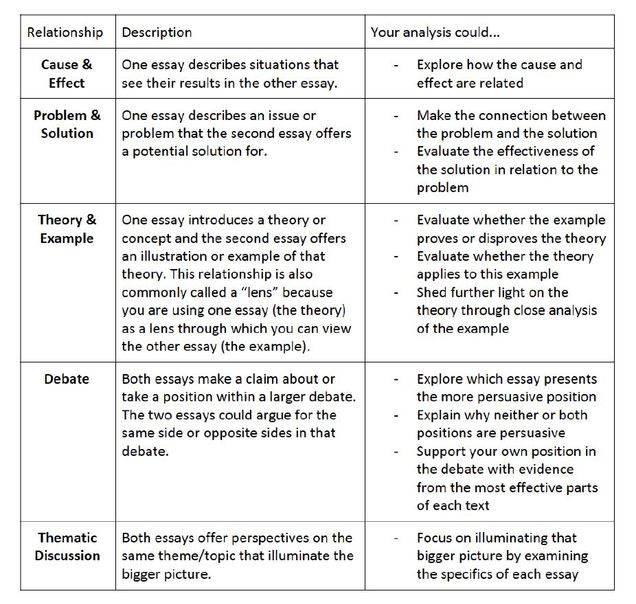
Comparative Analysis In-Class Activity
Goal: To practice writing and evaluating comparative analysis claims.
Materials: One laptop per group; your notes/annotations on reading material; Google doc link sent by your instructor.
Download Worksheet
Download Digital Implementation of the Activity
Graff, Gerald, and Cathy Birkenstein. They Say/I Say: The Moves That Matter in Academic Writing . 3rd ed., W.W. Norton & Co., 2014.
Tompkins, Case. “ Writing in Literature: Writing the Prompt Paper .” The Purdue OWL , Purdue U Writing Lab, 06 December 2013.
Walk, Kerry. “ How to Write a Comparative Analysis .” Harvard College Writing Center , 1998.
Endnote : This module follows the philosophy of the Writing Program and refers to the work of Kevin Barents, Holly Schaff, and Lesley Yoder for specific guidelines, categories, and best practices.

Want to create or adapt books like this? Learn more about how Pressbooks supports open publishing practices.
10.7 Comparison and Contrast
Learning objectives.
- Determine the purpose and structure of comparison and contrast in writing.
- Explain organizational methods used when comparing and contrasting.
- Understand how to write a compare-and-contrast essay.
The Purpose of Comparison and Contrast in Writing
Comparison in writing discusses elements that are similar, while contrast in writing discusses elements that are different. A compare-and-contrast essay , then, analyzes two subjects by comparing them, contrasting them, or both.
The key to a good compare-and-contrast essay is to choose two or more subjects that connect in a meaningful way. The purpose of conducting the comparison or contrast is not to state the obvious but rather to illuminate subtle differences or unexpected similarities. For example, if you wanted to focus on contrasting two subjects you would not pick apples and oranges; rather, you might choose to compare and contrast two types of oranges or two types of apples to highlight subtle differences. For example, Red Delicious apples are sweet, while Granny Smiths are tart and acidic. Drawing distinctions between elements in a similar category will increase the audience’s understanding of that category, which is the purpose of the compare-and-contrast essay.
Similarly, to focus on comparison, choose two subjects that seem at first to be unrelated. For a comparison essay, you likely would not choose two apples or two oranges because they share so many of the same properties already. Rather, you might try to compare how apples and oranges are quite similar. The more divergent the two subjects initially seem, the more interesting a comparison essay will be.
Writing at Work
Comparing and contrasting is also an evaluative tool. In order to make accurate evaluations about a given topic, you must first know the critical points of similarity and difference. Comparing and contrasting is a primary tool for many workplace assessments. You have likely compared and contrasted yourself to other colleagues. Employee advancements, pay raises, hiring, and firing are typically conducted using comparison and contrast. Comparison and contrast could be used to evaluate companies, departments, or individuals.
Brainstorm an essay that leans toward contrast. Choose one of the following three categories. Pick two examples from each. Then come up with one similarity and three differences between the examples.
- Romantic comedies
- Internet search engines
- Cell phones
Brainstorm an essay that leans toward comparison. Choose one of the following three items. Then come up with one difference and three similarities.
- Department stores and discount retail stores
- Fast food chains and fine dining restaurants
- Dogs and cats
The Structure of a Comparison and Contrast Essay
The compare-and-contrast essay starts with a thesis that clearly states the two subjects that are to be compared, contrasted, or both and the reason for doing so. The thesis could lean more toward comparing, contrasting, or both. Remember, the point of comparing and contrasting is to provide useful knowledge to the reader. Take the following thesis as an example that leans more toward contrasting.
Thesis statement: Organic vegetables may cost more than those that are conventionally grown, but when put to the test, they are definitely worth every extra penny.
Here the thesis sets up the two subjects to be compared and contrasted (organic versus conventional vegetables), and it makes a claim about the results that might prove useful to the reader.
You may organize compare-and-contrast essays in one of the following two ways:
- According to the subjects themselves, discussing one then the other
- According to individual points, discussing each subject in relation to each point
See Figure 10.1 “Comparison and Contrast Diagram” , which diagrams the ways to organize our organic versus conventional vegetables thesis.
Figure 10.1 Comparison and Contrast Diagram

The organizational structure you choose depends on the nature of the topic, your purpose, and your audience.
Given that compare-and-contrast essays analyze the relationship between two subjects, it is helpful to have some phrases on hand that will cue the reader to such analysis. See Table 10.3 “Phrases of Comparison and Contrast” for examples.
Table 10.3 Phrases of Comparison and Contrast
| Comparison | Contrast |
|---|---|
| one similarity | one difference |
| another similarity | another difference |
| both | conversely |
| like | in contrast |
| likewise | unlike |
| similarly | while |
| in a similar fashion | whereas |
Create an outline for each of the items you chose in Note 10.72 “Exercise 1” and Note 10.73 “Exercise 2” . Use the point-by-point organizing strategy for one of them, and use the subject organizing strategy for the other.
Writing a Comparison and Contrast Essay
First choose whether you want to compare seemingly disparate subjects, contrast seemingly similar subjects, or compare and contrast subjects. Once you have decided on a topic, introduce it with an engaging opening paragraph. Your thesis should come at the end of the introduction, and it should establish the subjects you will compare, contrast, or both as well as state what can be learned from doing so.
The body of the essay can be organized in one of two ways: by subject or by individual points. The organizing strategy that you choose will depend on, as always, your audience and your purpose. You may also consider your particular approach to the subjects as well as the nature of the subjects themselves; some subjects might better lend themselves to one structure or the other. Make sure to use comparison and contrast phrases to cue the reader to the ways in which you are analyzing the relationship between the subjects.
After you finish analyzing the subjects, write a conclusion that summarizes the main points of the essay and reinforces your thesis. See Chapter 15 “Readings: Examples of Essays” to read a sample compare-and-contrast essay.
Many business presentations are conducted using comparison and contrast. The organizing strategies—by subject or individual points—could also be used for organizing a presentation. Keep this in mind as a way of organizing your content the next time you or a colleague have to present something at work.
Choose one of the outlines you created in Note 10.75 “Exercise 3” , and write a full compare-and-contrast essay. Be sure to include an engaging introduction, a clear thesis, well-defined and detailed paragraphs, and a fitting conclusion that ties everything together.
Key Takeaways
- A compare-and-contrast essay analyzes two subjects by either comparing them, contrasting them, or both.
- The purpose of writing a comparison or contrast essay is not to state the obvious but rather to illuminate subtle differences or unexpected similarities between two subjects.
- The thesis should clearly state the subjects that are to be compared, contrasted, or both, and it should state what is to be learned from doing so.
There are two main organizing strategies for compare-and-contrast essays.
- Organize by the subjects themselves, one then the other.
- Organize by individual points, in which you discuss each subject in relation to each point.
- Use phrases of comparison or phrases of contrast to signal to readers how exactly the two subjects are being analyzed.
Writing for Success Copyright © 2015 by University of Minnesota is licensed under a Creative Commons Attribution-NonCommercial-ShareAlike 4.0 International License , except where otherwise noted.
How to Write a Critical Analysis Essay: Examples & Guide
A critical analysis essay is an academic paper that requires a thorough examination of theoretical concepts and ideas. It includes a comparison of facts, differentiation between evidence and argument, and identification of biases.
Crafting a good paper can be a daunting experience, but it will be much easier if you have the right approach. In this guide by our custom writing team, you will find:
- Different types of critical analysis;
- Best ways to structure your essay;
- Two excellent critical analysis essay examples.
- 📝 Critical Analysis Definition
- ✍️ Writing Guide
- ✅ Critical Analysis Types
- 📑 Examples & Tips
📝 What Is a Critical Analysis?
Criticism is the process of appraising things such as works of art and literature. It comes from the word meaning “able to make judgments”. A critical analysis essay is often referred to as a critical thinking essay, critical response paper, critical evaluation essay, and summary and response essay.
When we hear the word “criticism,” we often associate it with negative judgments. However, to criticize doesn’t necessarily mean to find faults. Even though criticism involves active disagreement, it strives to understand the meaning further and evaluate its efficiency. We call it constructive criticism .
In other words, critical analysis is an evaluation of a piece of work that promotes its better understanding . Have a look at this comparison and see what critical analysis is and what it isn’t:
| Critical analysis is: | Critical analysis is not: |
|---|---|
Aside from art and literature, critical analysis is often used in theoretical research, nursing, and social work. In any of these areas, you have an opportunity to exercise your critical faculties.
Analysis in Writing: Definition & Examples
Analysis is a step you take before writing any paper. It’s aimed at evaluating and interpreting the sources. To do it, you break them down and study them in detail. You can learn more from this article on critical analysis by Southeastern Louisiana University .
In the following table, we’ve compiled several forms of analysis in writing and illustrated each type with a topic example:
| Type of Analysis | Explanation | Topic example |
|---|---|---|
| Rhetorical Analysis | The purpose of this analysis type is to discover how a text persuades its readers. It can help you develop an ability to detect manipulations. | Techniques that Sir Ken Robinson to emotionally appeal to the viewer in his TED talk |
| Process Analysis | This form of analysis divides a business, social, or political process into several steps. There are two distinct types of process analysis: | How to purify water using carbon filtering. |
| Causal Analysis | This type of analysis focuses on the events that already happened and may try to predict what will happen in the future. Counter-arguments are a crucial part of the causal analysis. | Causes and effects of internet addiction among younger generations. |
| Critical analysis | This type of analysis aims to evaluate a work and to promote its better understanding. | The role of Zen Buddhism in JD Salinger’s . |
What Is the Difference between Summary and Analysis?
Students often confuse analysis with summary and get a lower grade as a result. Here is how two notions differ. A summary is a brief restatement of the text’s main points that involves paraphrasing. An analysis is a detailed examination of the evidence that uncovers something new.
Check out this comparison to understand the difference better:
| Summary | Analysis |
|---|---|
✍️ How to Write a Critical Analysis Essay
Now, we will show you the steps to writing a critical analysis with examples to guide you through this process. Keep in mind that the purpose of your critical analysis paper is to help readers understand a subject to a full extent.
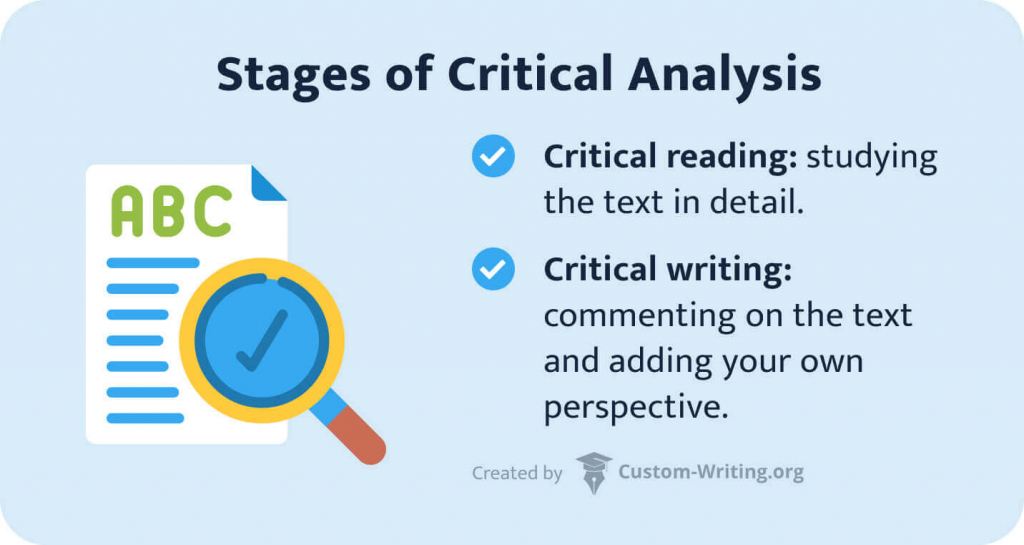
Critical analysis consists of two stages: critical reading and critical writing. Read on to learn more about them.
Critical Reading Examples & Definition
Critical reading a technique that involves discovering and evaluating the text’s meaning and incorporating it into what you already know. It’s the first stage of critical analysis.
According to Cleveland State University, critical reading occurs after you’ve skimmed the research material and decided where to focus your efforts. While you are reading, use the following techniques to stay on track:
- Determine the central claim and identify how it is argued;
- Look for the large patterns that give purpose, order, and meaning to arguments;
- Contextualize the text within an original historical, political, or religious context;
- Distinguish the kinds of reasoning and methodology the text employs;
- Examine the evidence;
- Recognize manipulations.
When it comes to recognizing manipulations, authors use three persuasive appeals to convince their readers of something: ethos , pathos , and logos .
| Ethos, or the appeal to ethics, refers to the author’s effort to convince you of their credibility through appropriate language. It refers to the author’s reputation and the reader’s trust. | |
| Pathos, or the appeal to feelings, refers to the effort to persuade a reader by making them feel a particular emotion. It is achieved through language, tone of voice, use of anecdotes, and metaphors. | |
| Logos, or the appeal to rationality, is persuasion through logic and reason. Storytelling, historical facts, recorded evidence, and exceptional arguments are the authors’ tools to convince you. |
Now, let’s apply the critical reading techniques to an actual text:
The death estimates during the US invasions of Tokyo were exaggerated by a factor of ten to twenty. The wartime casualty estimates were based on inaccurate assumptions. The data was not updated to exclude the civilians’ deaths and justify the strategic decision to drop off an atomic bomb.
- What is the text saying? US bombs killed up to two million people.
- What is the text doing? The death estimates were exaggerated to downplay the casualties and emphasize the importance of dropping the atomic bomb.
When you are able to recognize these persuasive modes in your reading, you can master them in writing.
What Is Critical Writing: Definition & Techniques
Critical writing is a process of commenting on another piece of work using several writing strategies. It is the second stage of critical analysis.
Want to know how to write critically? Have a look at the following tips:
- Take a critical stance: recognize that every text comes from a perspective and is subject to interpretation.
- Pay close attention: look not only for the facts but also for explanations.
- Think big picture : put your sources in context with the time it was written.
- Bring yourself in: consider the connections between several texts and add your own perspective.
When it comes to the critical writing, certain strategies can be beneficial. Yet, others are better to avoid. We’ve compiled the most important dos and don’ts in the table below:
| ✔️ Dos | ❌ Don’ts |
|---|---|
| . The more thorough you are with your primary and additional sources, the stronger your argument will be. . Credible sources and strong arguments will help you to prove your point. . The way you communicate your point and structure your paper will determine how confident your writing sounds. . Present the reader not only with facts and quotes but also with in-depth research and thorough analysis. | . The only essay part where you can take advantage of descriptive writing is the summary. . Question your sources and always back up your arguments. . Instead of drawing attention to yourself, focus on the strengths or weaknesses of the piece you are analyzing. . Always use proper citation style and have works cited page at the end of your paper. . Instead, re-read it out loud. Look for mistakes and missing information. |
Want to learn more? Check out our article on critical writing .
Critical Analysis Essay Topics: How to Choose
Now that you’ve learned about critical analysis, there is a big question to answer: how do you choose the topic for your essay? It might require using a specific strategy to make the right choice.
Many students find it helpful to have a list of critical thinking questions to answer while brainstorming. We’ve prepared them for you:
- Theme : How well does the author approach the central theme? Are the arguments strong enough?
- Organization : Is this piece of work well-structured and easy to follow?
- Audience : Who is the audience? Are there any manipulations the author is using to persuade the reader?
- Tone : Is there a specific tone used by the author throughout their work? How does it affect the reader?
- Bias and informational gaps : Does the author look at their work from several angles? Are there any contradicting arguments or missing information?
- Word choice : Does the author invent new words? Is the vocabulary serious or silly, casual or technical? How does it affect the overall writing?
- Logos : Does the author use logic to prove their point?
- Ethos : Does the author have any proof of their credibility? Do they claim to be an expert? In what ways is the reader’s trust gained?
- Pathos : Does the author use emotion to connect with the reader? Does the writing appeal to common beliefs and values?
Answering these questions will help you with deciding on critical thinking essay topics. If you want some additional inspiration, feel free to use our topic generator .
Critical Analysis Template
After carefully analyzing all of your sources, you can start writing your first draft using our critical analysis template. Use this outline to structure your essay and to ensure your arguments are related to your thesis.

How to Start a Critical Analysis Essay
To create an outstanding opening paragraph, you may want to start it with a hook. It can be a quote from your source or a rhetorical question. Be sure to make it catchy so that it will grab your reader’s attention.
After you’re done with the hook, write the following:
- the work’s title and some background information,
- an outline of the main ideas from your sources,
- your thesis statement.
Here are two introduction examples for your inspiration:
What happens when there is a considerable wage gap between the upper and middle classes? The unsurprising reality forces poor people to use credit cards to pay off their debt. Credit card industries collect interest from those who can’t pay off their debt right away.
A romantic novel Pride and Prejudice by Jane Austen is about overcoming social stereotypes in the name of love. Its main character, Elizabeth Bennet, has to fight against her discrimination against wealthy men like Mr. Darcy to find love and be happy.
Critical Analysis Essay: Thesis
A thesis statement is what you are aiming to prove. Ideally, it should be the first thing you write because every other part of your critical analysis paper will be connected to it.
To create a strong thesis statement, you want to start with a broader idea of what you would like to critique. Then, you narrow it down. Choose a debatable thesis so you can back it up with evidence from your sources and anchor your entire paper around it.
The examples below will help you write your essay’s thesis:
People in positions of power are less likely to recognize the social injustice than marginalized groups of the civilian population.
In a 1989 American superhero film Batman, Tim Burton subverts the concept of heroism by refraining Batman from murder and making him morally ambiguous.
Critical Analysis Essays: Summary and Response
The body paragraphs of a critical essay consist of your source’s summary and a response with arguments.

A summary should present specific facts from your source to help your reader understand your arguments better. You can use these sentence starters to structure a summary:
- The book is about…
- The theme of the article is…
- The author argues that…
- The author concludes…
- The main character is…
- The main points are…
The main plot of Elizabeth Bennet’s plan to save her family from poverty intersects with stereotypes that romantic love and marriage don’t go together. She does not accept a marriage proposal from Mr. Darcy because she does not want to be walking proof that women marry for money. The rejected proposal leads Darcy to open up and change Elizabeth’s perception of him.
A response should present your main arguments that support your thesis statement. Each argument is a sub-thesis that connects to your central thesis. It’s crucial to discuss each point in detail and prove it with strong evidence.
Your arguments should be:
- clear, informative, and persuasive;
- well-researched and backed up with solid evidence;
- connected to your thesis.
At first, Elizabeth Bennet sees Mr. Darcy only as a powerful man with wealth and high social status. For her, he represents a marriage of convenience that she is so desperately trying to fight against. After Mr. Darcy attempts to separate Jane and Bingley, Elizabeth gets proof for her ideas about powerful men who do everything in their power to destroy a loving relationship for a better financial suit.
Critical Essay Outline: Conclusion
The final stage of essay writing is to ensure you have proven your arguments. The goal of your conclusion is to remind the reader of your thesis and the essay’s main points. You may also want to leave them with some final statements for consideration.
Keep in mind that the concluding paragraph is not a place to introduce new evidence. Instead, you can do the following:
- Restate your thesis;
- Summarize your main ideas;
- Talk about the work’s overall performance or outcome;
- Identify potential opportunities for further research or investigation.
Elizabeth Bennet struggles with the societal association of marriage with financial stability. Eventually, she marries a rich man, Mr. Darcy, but she marries him for love rather than his money and social status. Her pride and prejudice towards him were destroyed by his acts of kindness and true love. Their relationship had a rough start, but both of them could get their happy ending by breaking out of old beliefs and habits.
✅ Types of Critical Analysis
Choosing the correct type of analysis will help you stay on track with your research objectives. It will give you the anchor to develop your essay around in a systematic manner.
Critical analysis can be categorized into 4 main types:
- Literary analysis gives a critical evaluation of a literary text.
- Article analysis reflects upon arguments presented in an article.
- Media analysis essay interprets messages conveyed through visual media, music, or radio.
- Cultural analysis interprets cultural phenomena and practices.
Literary Analysis: Definition & Characteristics
Literary analysis is an argument that expresses one’s critical evaluation of a poem, novel, short story, or play. A critique of literature has the same characteristics as other types of critical essays. The difference is the kind of information you can include in this type of essay.
Here’s how to analyze literature:
You will find more interesting info in our article on literary analysis essays .
How to Write an Analysis of an Article
Critical analysis of an article aims to analyze the writing strategies and techniques an author uses to develop their argument. The process is a little different than persuading the reader to accept a particular point of view. Here is a sample outline:
Critical Film Analysis: Types & How to Write
Film analysis goes beyond the plot structure and includes composition elements such as camera work, lighting, costume choices, etc. After watching the film at least twice, you can select what type of film analysis you will be performing. Check out the types and see what they’re about:
- Semiotic analysis involves interpretation of signs and symbols within a film.
- Narrative analysis examines the story the film seeks to tell.
- Historical analysis is an examination of a film’s relationship to a cultural or historical context.
- Mise-en-scène analysis is an analysis of compositional elements used in a scene or a single shot.
Once you’ve chosen a topic, use this outline to guide you through the writing process:
You can learn more from our article on film analysis .
How to Write a Cultural Analysis Essay
Critical analysis essay refers to your comment upon one specific cultural aspect that works or doesn’t work in a society. After you’ve chosen a topic for your cultural analysis paper, you can start drafting your outline. Here is how the structure of this kind of paper differs from others:
Critical Analysis Essay Topics
- Critical analysis of qualitative research article.
- Rhetorical analysis of articles on qualitative studies in healthcare.
- American Exodus by James N. Gregory: Rhetorical Analysis.
- Critical analysis of religion and faith .
- Analyze the sonnet My Mistress’ Eyes by W. Shakespeare .
- Critical essay on issues of cognitive neuroscience.
- A Doll House as an example of feminist literature: rhetorical analysis.
- Conduct a comparative critical analysis of Judaism and Christianity.
- Rhetorical analysis of an Anglo-Saxon poem Beowulf .
- Semantic meaning of The Bell Jar by Sylvia Plath .
- Critical evaluation of Seligman articles.
- Analyze psychological literature based on A Clean, Well-Lighted Place by E. Hemingway.
- Rhetorical analysis of literary devices and expressive means in A Good Man Is Hard to Find .
- Analyze the characteristic features of drama using the example of Death of a Salesman .
- Critical analysis of the most popular business strategies .
- Discuss the problem of childhood obesity in Active Living by Van Kann.
- Analyze IT strategies and planning.
- Critical analysis of a controversial art using the example of Home by Yann Arthus-Bertrand.
- Emotional impact of comedy films.
- Rhetorical analysis of Sophocles’ Antigone as an example of Greek drama.
- Influence of Socrate’s philosophy on the ancient Greek playwrights.
- Critical analysis of Sophocles’ plays.
- Different sets of values in Everyday Use by A. Walker .
- Analysis of corporate crimes using the example of Lehman Brothers’ scandal.
- Critical analysis of a scientific article based on Nursing Pain Management .
- Different interpretations of A Good Man Is Hard to Find by Flannery O’Connor.
- Critical analysis of Longinus’ idea of sublime .
- The importance of a teacher’s role in Freedom Writers .
- Critical analysis of the efficiency of CBT.
- Rhetorical analysis of an article on a proactive care program.
- The concept of emotional intelligence: critical analysis.
- Evaluate implementation of Windsome’s risk management strategy to enhance the company’s response to stress.
- The importance of symbolism in Truman Capote’s Breakfast at Tiffany’s .
- Critical analysis of Thomas Paine’s pamphlets.
- Rhetorical techniques used in Hamlet by W. Shakespeare .
- In-depth analysis of the modern world’s social issues in The Handmaid’s Tale .
- Social messages in Robinson’s and Kincaid’s stories.
- Analysis of rhetorical strategies used in Dwellings by Linda Hogan.
- Critical analysis of issues elucidated in A Loss for Words by J. Thurman.
- Discuss the problems of alienation and perception in The Things They Carried .
📑 Critical Analysis Essay Examples & Bonus Tips
The following writing tips will help you understand how to apply your critical thinking skills in practice and write an excellent critical essay on your own.
Critical Essay Format & Free Samples
Looking for some tips on how to format your paper? This section reflects the latest guidelines for citing your sources with the latest APA 7th and MLA 9th publication manuals.
| APA format | MLA format | |
|---|---|---|
| Not required. | ||
| Sources in alphabetical order. | Sources in alphabetical order. |
Before you dive into writing your critical analysis paper, get inspired with some compelling essay examples. The first is a film analysis example. You can download the PDF file below:
The Birds by Alfred Hitchcock is a thriller that derives its suspense from the violence which stands on the borderline with divine retribution. The birds of the film are the symbol of the said violence and primary actors that contribute to the semiotic revelations of the film.
The following critical analysis essay is concerned with a literary work. You can download it below:
Feminism has been influential in various aspects of society for many decades. With the beginning of women’s emancipation, humanity has progressed not only in political and social life but also in science, culture, and literary studies. A feminist standpoint in literature research points to the limited portrayal of the characters in literary works, which showed the world mainly from a patriarchal perspective.
Here’s the list of critical analysis essay examples. You can check them out to get a better understanding of critical analysis and to gain some inspiration.
- Managing Business Risks: A Critical Analysis
- Nursing Skills for Palliative Care: A Critical Analysis
- Critical Analysis of Quantitative vs. Qualitative Research
- Nighthawks by Edward Hopper: Critical Analysis
- Roosevelt and Obama: Critical Analysis of Two Speeches
- “The Love of My Life” by T. C. Boyle Critical Analysis
- Nursing Education-Practice Gap: Critical Analysis
- Affordable Care Act: A Critical Analysis
- Mother Tongue by Amy Tan: Critical Analysis
Bonus Tips: Critical Thinking
Critical thinking is the process of conceptualizing, applying, analyzing, synthesizing, and evaluating information. It is about careful reasoning directed to a goal. The main components of this process include observing, wondering, imagining, experimenting, judging, and deciding.
This type of thinking is instrumental in conducting a critical analysis. To succeed at it, you need to be attentive, confident, and open-minded. Below are some questions that you can ask yourself while thinking critically:
- Why are you being told this?
- What are you not being told?
- Who is telling you this?
- How reliable is this information?
- Are there any manipulations involved?
- How else can you analyze the same material?
Critical thinking is a skill that develops with time and effort. However, you may encounter barriers that can prevent you from making accurate judgments. The following tips will help you overcome them:
- Step back from your personal feelings and biases
- Look for different ways to examine the data
- Check your sources for reliability
- Do your best to detect manipulations in arguments
- Always conceptualize what you are reading
- Challenge your worldview
Want to learn more? Feel free to check out our article on critical thinking essays .
Now you know everything necessary to write a perfect critical analysis essay. Feel free to share this article or leave a comment!
Further reading
- How to Write a Critique Paper: Tips + Critique Essay Examples
- How to Write an Art Critique: Examples & Strategies
- How to Write an Analysis Essay: Examples + Writing Guide
- How to Write a Book Review: Format, Outline, & Example
- How to Write a Rhetorical Analysis Essay: Outline, Steps, & Examples
❓ Critical Analysis Essay FAQs
When analyzing any literary text, it is essential to evaluate the work and use the theme to support your opinion. The response’s goal is to show the reader what the selection of the source and the theme means to you personally.
The purpose of a response to a literature essay is to inform your reader about something interesting and insightful you found in a literary work. It may focus on the characters, plot, or theme of the story.
In a critical essay, choose the formal language and avoid using “I” statements. Focus on the piece you are analyzing, its strengths, and weaknesses. Using the first-person singular will take away the reader’s attention from your argument to you.
A critical source is a source that interprets, analyzes, critiques, and adds to the discussion of the primary source. It is then integrated into critical writing. The best critical sources can be found through library catalogs and scholarly databases.
🔍 References
- Critical Analysis: University of Wollongong
- Some Suggestions on Critically Evaluating Your Reading in History: Carleton College
- Criticism and Critical Analysis: Kansas State University
- Resources for Writers: Analytical Writing: Drew University
- Critical Thinking and Writing: University of Kent
- Writing Critical Essays about Literature: Gallaudet University
- Film Analysis: University of North Carolina at Chapel Hill
- Cultural Critique: Southern Illinois University Edwardsville
- Writing a Critical or Rhetorical Analysis: Bellevue College
- Writing Critical Analysis Papers: University of Washington
- Critical Analysis Template: Thompson Rivers University
- Writing Effective Summary and Response Essays: Colorado State University
- Rhetorical/Critical Analysis: Houston Community College
- Writing Critical Reviews: Queen’s University
- General APA Guidelines: Purdue University
- Using MLA Format: MLA.org
- Share to Facebook
- Share to Twitter
- Share to LinkedIn
- Share to email

Process analysis is an explanation of how something works or happens. Want to know more? Read the following article prepared by our custom writing specialists and learn about: So, let’s start digging deeper into this topic! ♻️ What Is Process Analysis? A process analysis describes and explains the succession of...

A visual analysis essay is an academic paper type that history and art students often deal with. It consists of a detailed description of an image or object. It can also include an interpretation or an argument that is supported by visual evidence. In this article, our custom writing experts...

Want to know how to write a reflection paper for college or school? To do that, you need to connect your personal experiences with theoretical knowledge. Usually, students are asked to reflect on a documentary, a text, or their experience. Sometimes one needs to write a paper about a lesson...

A character analysis is an examination of the personalities and actions of protagonists and antagonists that make up a story. It discusses their role in the story, evaluates their traits, and looks at their conflicts and experiences. You might need to write this assignment in school or college. Like any...

Any literary analysis is a challenging task since literature includes many elements that can be interpreted differently. However, a stylistic analysis of all the figurative language the poets use may seem even harder. You may never realize what the author actually meant and how to comment on it! While analyzing...

The difference between an argumentative and persuasive essay isn’t always clear. If you’re struggling with either style for your next assignment, don’t worry. The following will clarify everything you need to know so you can write with confidence. First, we define the primary objectives of argumentative vs. persuasive writing. We...

You don’t need to be a nerd to understand the general idea behind cause and effect essays. Let’s see! If you skip a meal, you get hungry. And if you write an essay about it, your goal is achieved! However, following multiple rules of academic writing can be a tough...
![critical analysis comparison essay How to Write an Argumentative Essay: 101 Guide [+ Examples]](https://custom-writing.org/blog/wp-content/uploads/2021/01/young-writer-taking-notes-284x153.jpg)
An argumentative essay is a genre of academic writing that investigates different sides of a particular issue. Its central purpose is to inform the readers rather than expressively persuade them. Thus, it is crucial to differentiate between argumentative and persuasive essays. While composing an argumentative essay, the students have to...
![critical analysis comparison essay How to Title an Essay: Guide with Creative Examples [2024]](https://custom-writing.org/blog/wp-content/uploads/2021/01/close-up-woman-making-greeting-card-new-year-christmas-2021-friends-family-scrap-booking-diy-writing-letter-with-best-wishes-design-her-homemade-card-holidays-celebration-284x153.jpg)
It’s not a secret that the reader notices an essay title first. No catchy hook or colorful examples attract more attention from a quick glance. Composing a creative title for your essay is essential if you strive to succeed, as it: Thus, how you name your paper is of the...

The conclusion is the last paragraph in your paper that draws the ideas and reasoning together. However, its purpose does not end there. A definite essay conclusion accomplishes several goals: Therefore, a conclusion usually consists of: Our experts prepared this guide, where you will find great tips on how to...
![critical analysis comparison essay How to Write a Good Introduction: Examples & Tips [2024 Upd.]](https://custom-writing.org/blog/wp-content/uploads/2021/01/closeup-shot-woman-working-studying-from-home-with-red-coffee-cup-nearby-284x153.jpg)
A five-paragraph essay is one of the most common academic assignments a student may face. It has a well-defined structure: an introduction, three body paragraphs, and a conclusion. Writing an introduction can be the most challenging part of the entire piece. It aims to introduce the main ideas and present...

Exemplification essays, also called illustration essays, are one of the easiest papers to write. However, even the simplest tasks require experience and practice. It is a good idea to find and analyze free exemplification essay examples. You can also ask your teacher to give you some sample exemplification essays from...

Instructor Resources
Comparative essay.
Compare two or more literary works that we have studied in this class. Your comparative essay should not only compare but also contrast the literary texts, addressing the similarities and differences found within the texts.
Step 1: Identify the Basis for Comparison
Identify the basis of comparison. In other words, what aspect of the literature will you compare? (Theme, tone, point of view, setting, language, etc.)
Step 2: Create a List of Similarities and Differences
Carefully examine the literary texts for similarities and difference using the criteria you identified in step 1.
Step 3: Write a Thesis Statement
A thesis statement is the author’s educated opinion that can be defended. For a comparative essay, your thesis statement should assert why the similarities and differences between the literary works matter.
Step 4: Create a Structure
Before drafting, create an outline. Your introduction should draw the reader in and provide the thesis statement. The supporting paragraphs should begin with a topic sentence that supports your thesis statement; each topic sentence should then be supported with textual evidence. The conclusion should summarize the essay and prompt the reader to continue thinking about the topic.
Word Count: approximately 1500 words
Outside Sources needed: none (but use plenty of textual evidence)
- Comparative Essay. License : CC0: No Rights Reserved
- Privacy Policy

Home » Critical Analysis – Types, Examples and Writing Guide
Critical Analysis – Types, Examples and Writing Guide
Table of Contents

Critical Analysis
Definition:
Critical analysis is a process of examining a piece of work or an idea in a systematic, objective, and analytical way. It involves breaking down complex ideas, concepts, or arguments into smaller, more manageable parts to understand them better.
Types of Critical Analysis
Types of Critical Analysis are as follows:
Literary Analysis
This type of analysis focuses on analyzing and interpreting works of literature , such as novels, poetry, plays, etc. The analysis involves examining the literary devices used in the work, such as symbolism, imagery, and metaphor, and how they contribute to the overall meaning of the work.
Film Analysis
This type of analysis involves examining and interpreting films, including their themes, cinematography, editing, and sound. Film analysis can also include evaluating the director’s style and how it contributes to the overall message of the film.
Art Analysis
This type of analysis involves examining and interpreting works of art , such as paintings, sculptures, and installations. The analysis involves examining the elements of the artwork, such as color, composition, and technique, and how they contribute to the overall meaning of the work.
Cultural Analysis
This type of analysis involves examining and interpreting cultural artifacts , such as advertisements, popular music, and social media posts. The analysis involves examining the cultural context of the artifact and how it reflects and shapes cultural values, beliefs, and norms.
Historical Analysis
This type of analysis involves examining and interpreting historical documents , such as diaries, letters, and government records. The analysis involves examining the historical context of the document and how it reflects the social, political, and cultural attitudes of the time.
Philosophical Analysis
This type of analysis involves examining and interpreting philosophical texts and ideas, such as the works of philosophers and their arguments. The analysis involves evaluating the logical consistency of the arguments and assessing the validity and soundness of the conclusions.
Scientific Analysis
This type of analysis involves examining and interpreting scientific research studies and their findings. The analysis involves evaluating the methods used in the study, the data collected, and the conclusions drawn, and assessing their reliability and validity.
Critical Discourse Analysis
This type of analysis involves examining and interpreting language use in social and political contexts. The analysis involves evaluating the power dynamics and social relationships conveyed through language use and how they shape discourse and social reality.
Comparative Analysis
This type of analysis involves examining and interpreting multiple texts or works of art and comparing them to each other. The analysis involves evaluating the similarities and differences between the texts and how they contribute to understanding the themes and meanings conveyed.
Critical Analysis Format
Critical Analysis Format is as follows:
I. Introduction
- Provide a brief overview of the text, object, or event being analyzed
- Explain the purpose of the analysis and its significance
- Provide background information on the context and relevant historical or cultural factors
II. Description
- Provide a detailed description of the text, object, or event being analyzed
- Identify key themes, ideas, and arguments presented
- Describe the author or creator’s style, tone, and use of language or visual elements
III. Analysis
- Analyze the text, object, or event using critical thinking skills
- Identify the main strengths and weaknesses of the argument or presentation
- Evaluate the reliability and validity of the evidence presented
- Assess any assumptions or biases that may be present in the text, object, or event
- Consider the implications of the argument or presentation for different audiences and contexts
IV. Evaluation
- Provide an overall evaluation of the text, object, or event based on the analysis
- Assess the effectiveness of the argument or presentation in achieving its intended purpose
- Identify any limitations or gaps in the argument or presentation
- Consider any alternative viewpoints or interpretations that could be presented
- Summarize the main points of the analysis and evaluation
- Reiterate the significance of the text, object, or event and its relevance to broader issues or debates
- Provide any recommendations for further research or future developments in the field.
VI. Example
- Provide an example or two to support your analysis and evaluation
- Use quotes or specific details from the text, object, or event to support your claims
- Analyze the example(s) using critical thinking skills and explain how they relate to your overall argument
VII. Conclusion
- Reiterate your thesis statement and summarize your main points
- Provide a final evaluation of the text, object, or event based on your analysis
- Offer recommendations for future research or further developments in the field
- End with a thought-provoking statement or question that encourages the reader to think more deeply about the topic
How to Write Critical Analysis
Writing a critical analysis involves evaluating and interpreting a text, such as a book, article, or film, and expressing your opinion about its quality and significance. Here are some steps you can follow to write a critical analysis:
- Read and re-read the text: Before you begin writing, make sure you have a good understanding of the text. Read it several times and take notes on the key points, themes, and arguments.
- Identify the author’s purpose and audience: Consider why the author wrote the text and who the intended audience is. This can help you evaluate whether the author achieved their goals and whether the text is effective in reaching its audience.
- Analyze the structure and style: Look at the organization of the text and the author’s writing style. Consider how these elements contribute to the overall meaning of the text.
- Evaluate the content : Analyze the author’s arguments, evidence, and conclusions. Consider whether they are logical, convincing, and supported by the evidence presented in the text.
- Consider the context: Think about the historical, cultural, and social context in which the text was written. This can help you understand the author’s perspective and the significance of the text.
- Develop your thesis statement : Based on your analysis, develop a clear and concise thesis statement that summarizes your overall evaluation of the text.
- Support your thesis: Use evidence from the text to support your thesis statement. This can include direct quotes, paraphrases, and examples from the text.
- Write the introduction, body, and conclusion : Organize your analysis into an introduction that provides context and presents your thesis, a body that presents your evidence and analysis, and a conclusion that summarizes your main points and restates your thesis.
- Revise and edit: After you have written your analysis, revise and edit it to ensure that your writing is clear, concise, and well-organized. Check for spelling and grammar errors, and make sure that your analysis is logically sound and supported by evidence.
When to Write Critical Analysis
You may want to write a critical analysis in the following situations:
- Academic Assignments: If you are a student, you may be assigned to write a critical analysis as a part of your coursework. This could include analyzing a piece of literature, a historical event, or a scientific paper.
- Journalism and Media: As a journalist or media person, you may need to write a critical analysis of current events, political speeches, or media coverage.
- Personal Interest: If you are interested in a particular topic, you may want to write a critical analysis to gain a deeper understanding of it. For example, you may want to analyze the themes and motifs in a novel or film that you enjoyed.
- Professional Development : Professionals such as writers, scholars, and researchers often write critical analyses to gain insights into their field of study or work.
Critical Analysis Example
An Example of Critical Analysis Could be as follow:
Research Topic:
The Impact of Online Learning on Student Performance
Introduction:
The introduction of the research topic is clear and provides an overview of the issue. However, it could benefit from providing more background information on the prevalence of online learning and its potential impact on student performance.
Literature Review:
The literature review is comprehensive and well-structured. It covers a broad range of studies that have examined the relationship between online learning and student performance. However, it could benefit from including more recent studies and providing a more critical analysis of the existing literature.
Research Methods:
The research methods are clearly described and appropriate for the research question. The study uses a quasi-experimental design to compare the performance of students who took an online course with those who took the same course in a traditional classroom setting. However, the study may benefit from using a randomized controlled trial design to reduce potential confounding factors.
The results are presented in a clear and concise manner. The study finds that students who took the online course performed similarly to those who took the traditional course. However, the study only measures performance on one course and may not be generalizable to other courses or contexts.
Discussion :
The discussion section provides a thorough analysis of the study’s findings. The authors acknowledge the limitations of the study and provide suggestions for future research. However, they could benefit from discussing potential mechanisms underlying the relationship between online learning and student performance.
Conclusion :
The conclusion summarizes the main findings of the study and provides some implications for future research and practice. However, it could benefit from providing more specific recommendations for implementing online learning programs in educational settings.
Purpose of Critical Analysis
There are several purposes of critical analysis, including:
- To identify and evaluate arguments : Critical analysis helps to identify the main arguments in a piece of writing or speech and evaluate their strengths and weaknesses. This enables the reader to form their own opinion and make informed decisions.
- To assess evidence : Critical analysis involves examining the evidence presented in a text or speech and evaluating its quality and relevance to the argument. This helps to determine the credibility of the claims being made.
- To recognize biases and assumptions : Critical analysis helps to identify any biases or assumptions that may be present in the argument, and evaluate how these affect the credibility of the argument.
- To develop critical thinking skills: Critical analysis helps to develop the ability to think critically, evaluate information objectively, and make reasoned judgments based on evidence.
- To improve communication skills: Critical analysis involves carefully reading and listening to information, evaluating it, and expressing one’s own opinion in a clear and concise manner. This helps to improve communication skills and the ability to express ideas effectively.
Importance of Critical Analysis
Here are some specific reasons why critical analysis is important:
- Helps to identify biases: Critical analysis helps individuals to recognize their own biases and assumptions, as well as the biases of others. By being aware of biases, individuals can better evaluate the credibility and reliability of information.
- Enhances problem-solving skills : Critical analysis encourages individuals to question assumptions and consider multiple perspectives, which can lead to creative problem-solving and innovation.
- Promotes better decision-making: By carefully evaluating evidence and arguments, critical analysis can help individuals make more informed and effective decisions.
- Facilitates understanding: Critical analysis helps individuals to understand complex issues and ideas by breaking them down into smaller parts and evaluating them separately.
- Fosters intellectual growth : Engaging in critical analysis challenges individuals to think deeply and critically, which can lead to intellectual growth and development.
Advantages of Critical Analysis
Some advantages of critical analysis include:
- Improved decision-making: Critical analysis helps individuals make informed decisions by evaluating all available information and considering various perspectives.
- Enhanced problem-solving skills : Critical analysis requires individuals to identify and analyze the root cause of a problem, which can help develop effective solutions.
- Increased creativity : Critical analysis encourages individuals to think outside the box and consider alternative solutions to problems, which can lead to more creative and innovative ideas.
- Improved communication : Critical analysis helps individuals communicate their ideas and opinions more effectively by providing logical and coherent arguments.
- Reduced bias: Critical analysis requires individuals to evaluate information objectively, which can help reduce personal biases and subjective opinions.
- Better understanding of complex issues : Critical analysis helps individuals to understand complex issues by breaking them down into smaller parts, examining each part and understanding how they fit together.
- Greater self-awareness: Critical analysis helps individuals to recognize their own biases, assumptions, and limitations, which can lead to personal growth and development.
About the author
Muhammad Hassan
Researcher, Academic Writer, Web developer
You may also like

Research Results Section – Writing Guide and...

Research Summary – Structure, Examples and...

Delimitations in Research – Types, Examples and...

Context of the Study – Writing Guide and Examples

Research Gap – Types, Examples and How to...

Research Approach – Types Methods and Examples
Home — Essay Samples — Business — Management — Comparative Analysis
Essays on Comparative Analysis
Rosencrantz and guildenstern: a comparative analysis, beowulf: a comparative analysis of heroism and culture, made-to-order essay as fast as you need it.
Each essay is customized to cater to your unique preferences
+ experts online
Hektor and Achilleus: a Comparative Analysis
Shakespeare’s king lear and shirwadkar natsamrat: a comparative study, comparative analysis of the writings of jonathan edwards and thomas paine, comparative analysis of the two types of lifestyles: hunting and gathering vs. settlements and agriculture, let us write you an essay from scratch.
- 450+ experts on 30 subjects ready to help
- Custom essay delivered in as few as 3 hours
Comparing and Contrasting Analysis of The Maximalist and Minimalist Democracy
Analysis of "it’s me" by huma bhabha and "dancing figure" in terms of portraying the human figure, comparative analysis in art: pablo picasso and henry moore, compare and contrast analysis of roman and greek culture, get a personalized essay in under 3 hours.
Expert-written essays crafted with your exact needs in mind
Comparative Analysis of The Works of Charlie Chaplin and Buster Keaton
Comparative analysis of csr programs of mcdonald's and nando, comparative analysis of "ain’t i woman" by isabella baumfree and "lynching and the excuse for it" by ida b. wells-barnett, analysis of connections between the "growing up with poverty and violence: a north lawndale teen’s story" by daleen glanten and "the autobiography of malcolm x" by alex haley, othello and o the movie: a comparative analysis of two works, jd sports and itunes comparative analysis, comparative analysis: disengagement vs. activity theory in caregiving, comparative analysis of streetcorner man and the handsomest drowned man in the world, comparative analysis of the original and the adaptation versions of king kong, cat on a hot tin roof: film vs play comparison, porter's 5-forces analysis of honda, toyota and nissan, social policy problems and income inequality, analysis of the features of two contrasting businesses: marks and spencer and nspcc, overview of digital marketing in comparison to the traditional one, bhagavad-gita and dante’s inferno: a religious comparative, static and dynamic analysis, comparison or rome and persia, india & brics: comparative analysis, the analogies between john green's books, comparative analysis: merger surge in 1960s to 1980s.
Comparative analysis is the process of comparing items to one another and distinguishing their similarities and differences.
Relevant topics
- Time Management
- Madam Cj Walker
- Advertisement
- John D. Rockefeller
By clicking “Check Writers’ Offers”, you agree to our terms of service and privacy policy . We’ll occasionally send you promo and account related email
No need to pay just yet!
We use cookies to personalyze your web-site experience. By continuing we’ll assume you board with our cookie policy .
- Instructions Followed To The Letter
- Deadlines Met At Every Stage
- Unique And Plagiarism Free
Compare And Contrast Essay Guide
Compare And Contrast Essay Examples
Last updated on: Mar 22, 2024
Good Compare and Contrast Essay Examples For Your Help
By: Barbara P.
Reviewed By: Jacklyn H.
Published on: Mar 22, 2023

Are you ready to challenge your critical thinking skills and take your writing to the next level? Look no further than the exciting world of compare and contrast essays!
As a college student, you'll have the unique opportunity to delve into the details and differences of a variety of subjects. But don't let the pressure of writing the perfect compare-and-contrast essay weigh you down.
To help guide you on this journey, we've got some great compare-and-contrast essay examples. It will make the writing process not only manageable but also enjoyable. So grab a pen and paper, and let's get started on this exciting adventure!

On this Page
Good Compare and Contrast Essay Examples
A compare and contrast essay is all about comparing two subjects. Writing essays is not always easy, but it can be made easier with help from the examples before you write your own first. The examples will give you an idea of the perfect compare-and-contrast essay.
We have compiled a selection of free compare-and-contrast essay examples that can help you structure this type of essay.
SAMPLE COMPARE AND CONTRAST ESSAY EXAMPLE
COMPARE AND CONTRAST ESSAY INTRODUCTION EXAMPLE
BOOK COMPARE AND CONTRAST ESSAY
CITY COMPARE AND CONTRAST ESSAY
CATS & DOGS COMPARE AND CONTRAST ESSAY
SCIENCE & ART COMPARE AND CONTRAST ESSAY
E-BOOKS & HARDBACK BOOKS COMPARE AND CONTRAST ESSAY
HOMESCHOOLING BOOKS COMPARE AND CONTRAST ESSAY
PARENTING STYLES COMPARE AND CONTRAST ESSAY
CONVENTIONAL AND ALTERNATIVE MEDICINE COMPARE AND CONTRAST ESSAY
Don't know how to map out your compare and contrast essay? Visit this link to learn how to perfectly outline your essay!
Compare and Contrast Essay Examples University
Compare and contrast paper is a common assignments for university students. This type of essay tells the reader how two subjects are the same or different from each other. Also, show the points of comparison between the two subjects.
Look at the example that is mentioned below and create a well-written essay.
COMPARE AND CONTRAST ESSAY EXAMPLE UNIVERSITY
Compare and Contrast Essay Examples College
COMPARE AND CONTRAST ESSAY EXAMPLE COLLEGE
Compare and Contrast Essay Examples High School
Compare and contrast essays are often assigned to high school students to help them improve their analytical skills .
In addition, some teachers assign this type of essay because it is a great way for students to improve their analytical and writing skills.
COMPARE AND CONTRAST ESSAY EXAMPLE HIGH SCHOOL
COMPARE AND CONTRAST ESSAY EXAMPLE 9TH GRADE
Check out the video below to gain a quick and visual comprehension of what a compare and contrast essay entails.
Compare and Contrast Essay Examples Middle school
In middle school, students have the opportunity to write a compare-and-contrast essay. It does not require an expert level of skills, but it is still a way to improve writing skills.
Middle school students can easily write a compare-and-contrast essay with a little help from examples. We have gathered excellent examples of this essay that you can use to get started.
COMPARE AND CONTRAST ESSAY EXAMPLE MIDDLE SCHOOL
COMPARE AND CONTRAST ESSAY EXAMPLES 5TH GRADE
Literary Analysis Compare and Contrast Essay Examples
The perfect way to inform readers about the pros and cons of two subjects is with a comparison and contrast essay.
It starts by stating the thesis statement, and then you explain why these two subjects are being compared in this essay.
The following is an example that you can use for your help.
LITERARY ANALYSIS COMPARE AND CONTRAST ESSAY EXAMPLE

Tough Essay Due? Hire Tough Writers!
Compare and Contrast Essay Conclusion Example
The conclusion of an essay is the last part, in which you wrap up everything. It should not include a story but rather summarize the whole document so readers have something meaningful they can take away from it.
COMPARE AND CONTRAST ESSAY CONCLUSION EXAMPLE
Struggling to think of the perfect compare-and-contrast essay topic ? Visit this link for a multitude of inspiring ideas.
Compare and Contrast Essay Writing Tips
A compare and contrast essay presents the facts point by point, and mostly, the argumentative essay uses this compared-contrasted technique for its subjects.
If you are looking for some easy and simple tips to craft a perfectly researched and structured compare and contrast essay, we will not disappoint you.
Following are some quick tips that you can keep in mind while writing your essay:
- Choose the essay topic carefully.
- Research and brainstorm the points that make them similar and different.
- Create and add your main statement and claim.
- Create a Venn diagram and show the similarities and differences.
- Choose the design through which you will present your arguments and claims.
- Create compare and contrast essay outline. Use either the block method or the point-by-point structure.
- Research and add credible supporting evidence.
- Transitioning is also important. Use transitional words and phrases to engage your readers.
- Edit, proofread, and revise the essay before submission.

Create captivating essays effortlessly!
In conclusion, writing a compare and contrast essay can be an effective way to explore the similarities and differences between two topics. By using examples, it is possible to see the different approaches that can be taken when writing this type of essay.
Whether you are a student or a professional writer, these examples can provide valuable insight to enhance your writing skills. You can also use our AI-powered essay typer to generate sample essays for your specific topic and subject.
However, if you don’t feel confident in your writing skills, you can always hire our professional essay writer.
5StarEssays.com offer comprehensive essay writing service for students across the globe. Our experts are highly trained and qualified, making sure all of your essays will meet academic requirements while receiving top grades.
Don't wait - take advantage of our 50% introductory discount today and get ahead of the game with us!
Frequently Asked Questions
How do i write a compare and contrast essay.
Here are some steps that you should follow and write a great essay.
- Begin by brainstorming with a Venn diagram.
- Create a thesis statement.
- Develop an outline.
- Write the introduction.
- Write the body paragraphs.
- Write the conclusion.
- Proofreading.
How do you start a compare and contrast essay introduction?
When writing a compare and contrast essay, it is important to have an engaging introduction that will grab the reader's attention. A good way to do this would be by starting with a question or fact related to the topic to catch their interest.
What are some good compare and contrast essay topics?
Here are some good topics for compare and contrast essay:
- E-books or textbooks.
- Anxiety vs. Depression.
- Vegetables and fruits.
- Cinnamon vs. sugar.
- Similarities between cultural and traditional fashion trends.
How long is a compare and contrast essay?
Usually, a compare and contrast essay would consist of five paragraphs but there are no hard and fast rules regarding it. Some essays could be longer than five paragraphs, based on the scope of the topic of the essay.
What are the two methods for arranging a comparison and contrast essay?
The two ways to organize and arrange your compare and contrast essay. The first one is the Point-by-Point method and the second one is the Block method.

Dr. Barbara is a highly experienced writer and author who holds a Ph.D. degree in public health from an Ivy League school. She has worked in the medical field for many years, conducting extensive research on various health topics. Her writing has been featured in several top-tier publications.
Was This Blog Helpful?
Keep reading.
- Compare and Contrast Essay - A Complete Guide With Topics & Examples

- Compare and Contrast Essay Topics: 100+ Fresh New Ideas

- Compare and Contrast Essay Outline - Template & Examples

People Also Read
- analytical essay writing
- essay writing tips
- speech writing
- writing an analytical essay
- list of social issues
Burdened With Assignments?

Advertisement
- Homework Services: Essay Topics Generator
© 2024 - All rights reserved

How to Write a Comparative Critique

How to Write a Review of a Poetry Book
Writing a comparative critique is an essential part of a person's college education. Critical writing and analysis is even more important for someone interested in pursuing further degrees in graduate school. The process compels the student to sharpen and fine-tune her critical and analytical skills and avoid the pitfalls of simply digesting information passively from a textbook. Comparing two topics allows the student to approach the topic from more than one perspective.
Select a topic, issue or problem to address. If the comparative critique is a college assignment, the professor may assign a topic or may suggest the student select a topic that relates to the course. The goal of a comparative critique is to focus on two things that are related, such as two characters in a novel, two authors, two political or literary theories and so forth.
Pick a frame of reference for the critique. The frame of reference may be a particular philosophical framework, such as Marxism, phenomenology, feminism or analytic philosophy, a literary criticism framework, such as hermeneutics or post-structuralism, or a psychological framework, such as psychoanalysis. The framework provides a context and tools for the critique. For example, a feminist critique may compare and contrast the way women are portrayed in two historical novels.
Present the rationale and grounds for selecting the two topics or issues. In other words, consider why the particular comparison is important. The goal is to convince the reader that a critical comparison has something important to contribute to the discussion.
Make a list of similarities and differences shared by the two objects of the study. For example, the Republican and Democratic parties share a number of things in common, such as belief in representative and democratic forms of government, a belief in the separation of powers, a commitment to the principles of the Constitution and a belief in the capitalist economic system. However, there are a number of disagreements, as well, over the role of state intervention in the economy, the government's role and responsibility in regards to the economically disadvantaged and so forth.
Develop a strong thesis statement. The thesis should one or two sentences of the introduction. One way to do this is to state or pose a problem with the first sentence and then answer the problem with the second sentence. State your position in clear, strong and unambiguous language. The thesis tells the reader why the comparison is important, the essential steps and arguments used in the comparison and the conclusion reached by the comparison.
Write a rough draft of the critique. Avoid the trap of thinking everything has to be clearly worked out in your mind before writing. The writing process helps to think through and clarify the ideas of the critique. Allow the rough draft to sit for a day or two. Approach it with a fresh mind. Carefully proofread it and make improvements to the form and content.
Write the final version of the critique based on the revisions of the original draft. Conclude the critique with a summary that touches on all the essential points of the critique.
Related Articles

How to Do a Summary for a Research Paper

What Is the Difference Between an Abstract and a Thesis Statement?
How to write a rebuttal speech.
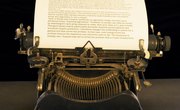
Activities for Writing Introductions & Conclusions

How to Outline a Case for Legal Studies

How to Set Up a Rhetorical Analysis

How to Write an Introduction to an Analytical Essay
How to write a definition essay.
- Writing Center at Harvid University; "How to Write a Comparative Analysis;" Kelly Walk; 1998
Robert Russell began writing online professionally in 2010. He holds a Ph.D. in philosophy and is currently working on a book project exploring the relationship between art, entertainment and culture. He is the guitar player for the nationally touring cajun/zydeco band Creole Stomp. Russell travels with his laptop and writes many of his articles on the road between gigs.

Comparison Contrast Essay
Comparison contrast essay generator.

The art of essay writing is a skill that is not only essential for students but also for professionals. It is a tool that helps in expressing thoughts, ideas, and arguments in a structured and coherent manner. Among the various types of essays, the Comparison and Contrast Essay holds a unique place. This article will guide you through 29+ Comparison and Contrast Essay Examples available in Google Docs, Word, PDF, and will also provide a step-by-step guide on how to write one.
1. Comparison And Contrast Essay Example
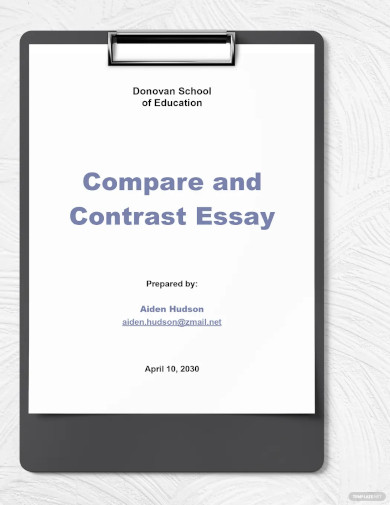
- Google Docs
2. Sample Comparison and Contrast Essay Example

Size: 45 KB
3. Comparison and Contrast Essay Structure Example
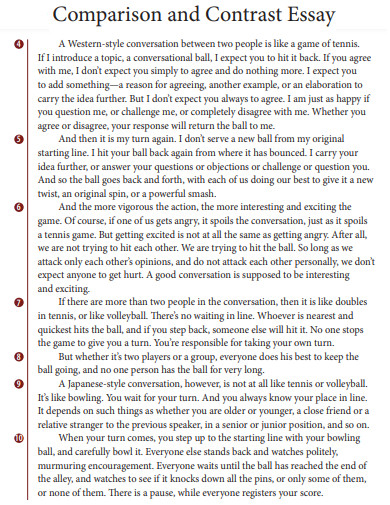
4. College Level Comparison and Contrast Essay Example
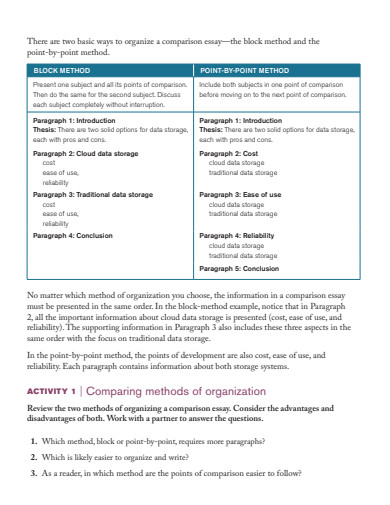
Size: 45 MB
5. Comparison and Contrast Essay Technology Example
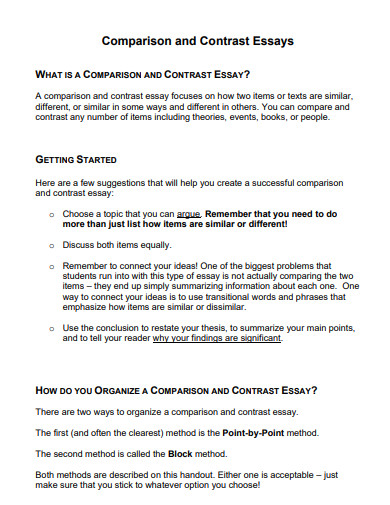
Size: 14 KB
6. Comparison and Contrast Essay Body Paragraph Example
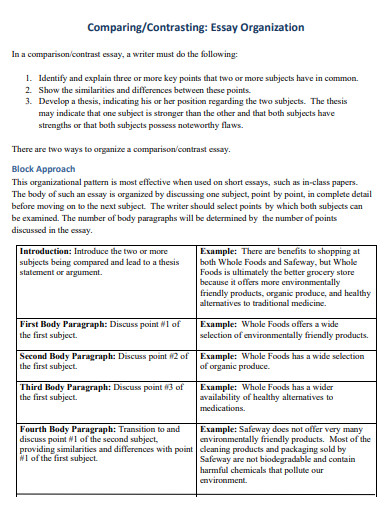
Size: 134 KB
7. Comparison and Contrast Essay Thesis Statement Example

Size: 366 KB
8. College Comparison and Contrast Essay Example
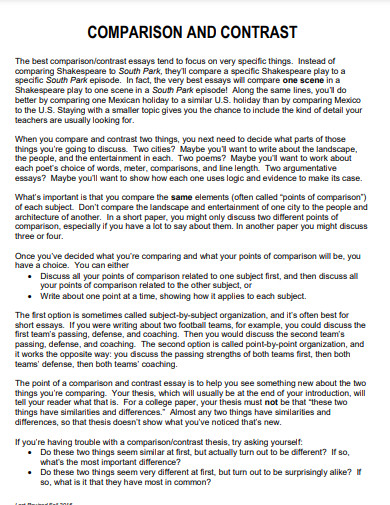
Size: 141 KB
9. Comparison and Contrast Essay Rough Draft Example
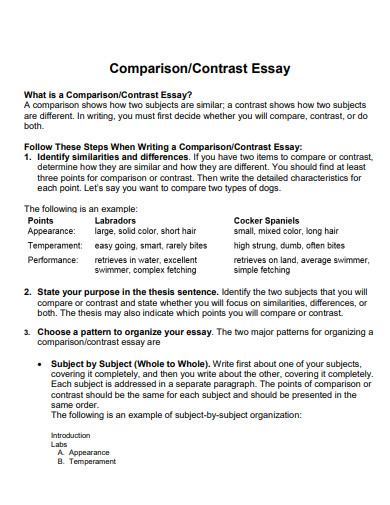
Size: 115 KB
10. Comparison and Contrast Essay Similarities Example
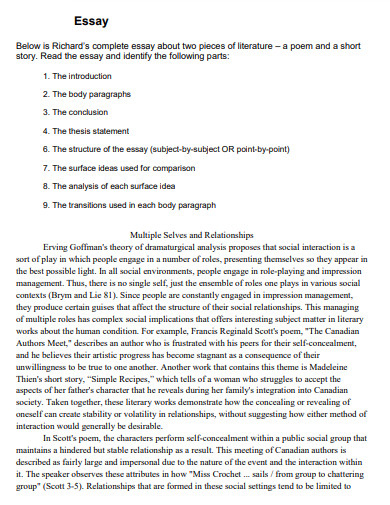
Size: 539 KB
11. Comparison and Contrast Essay Final Draft Example

Size: 557 KB
12. Comparison and Contrast Essay Topics Example

Size: 92 KB
13. Comparison and Contrast Essay Writing Example
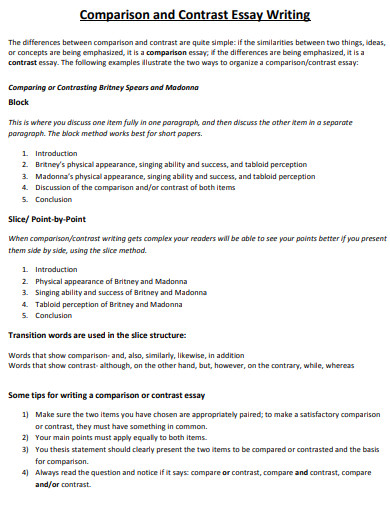
Size: 60 KB
14. Comparison and Contrast Essay Guideline Example

Size: 261 KB
15. Comparison and Contrast Essay Writing Process
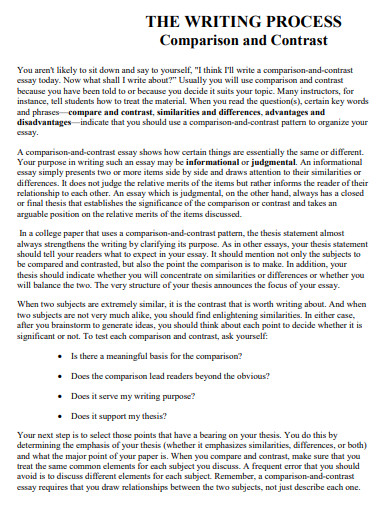
Size: 34 KB
16. Simple Comparison and Contrast Essay Example
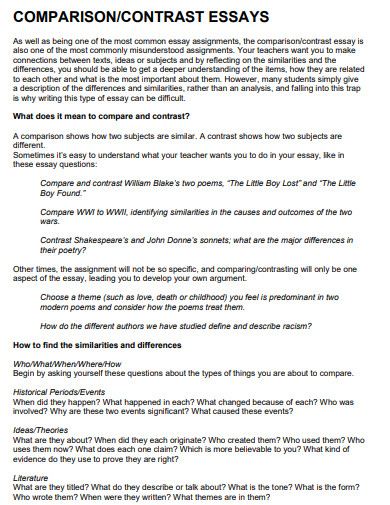
Size: 277 KB
17. Free Comparison and Contrast Essay Example
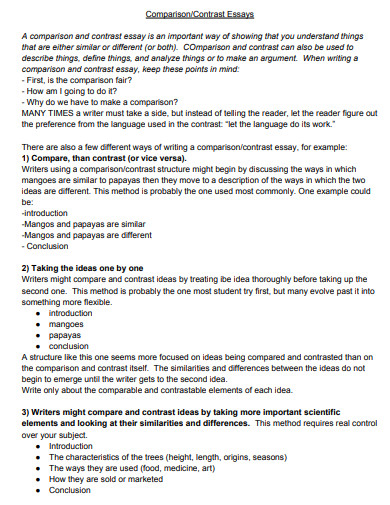
Size: 82 KB
18. Basic Comparison and Contrast Essay Example
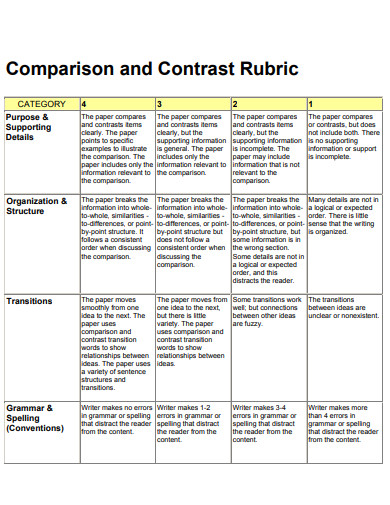
Size: 72 KB
19. Comparison and Contrast Essay Rubic Example
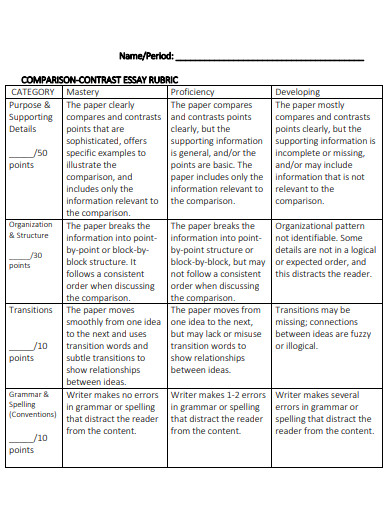
Size: 58 KB
20. Standard Comparison and Contrast Essay Example
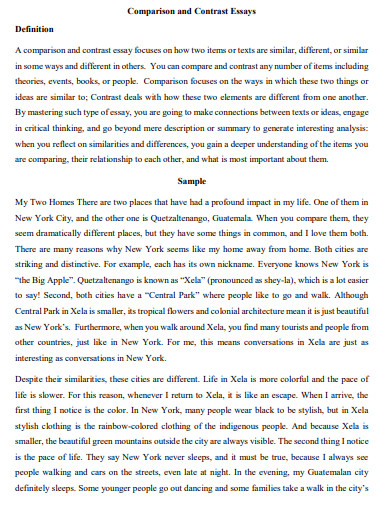
Size: 130 KB
21. Organization of Comparison and Contrast Essay

Size: 194 KB
22. Comparison and Contrast Essay Template
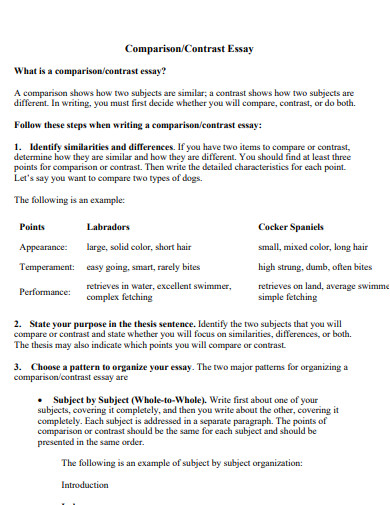
Size: 21 KB
23. Comparison and Contrast Essay Introduction
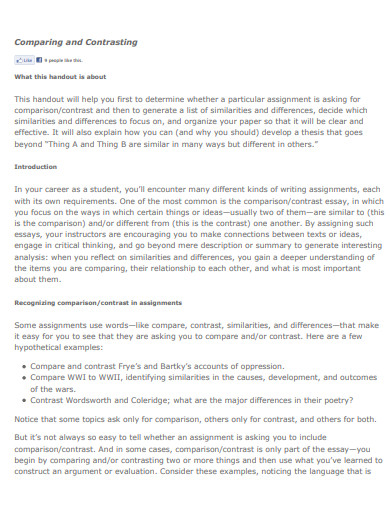
Size: 114 KB
24. Comparison and Contrast Essay Paper Example
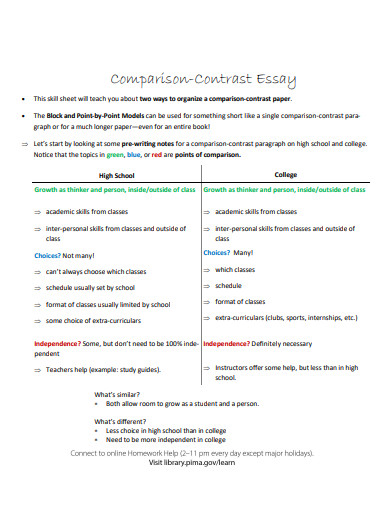
Size: 965 KB
25. Literary of Comparison and Contrast Essay
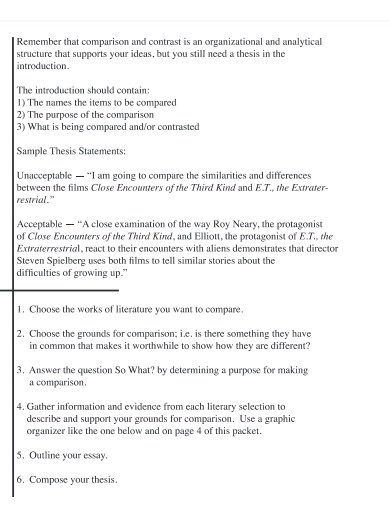
26. General Comparison and Contrast Essay Example
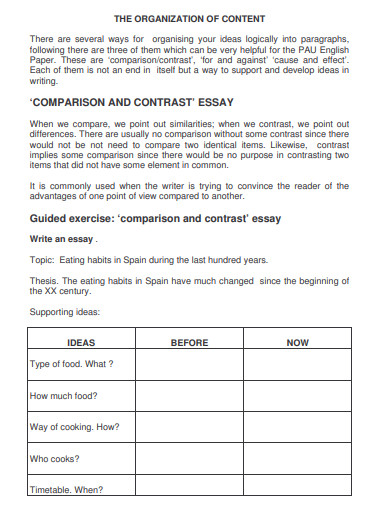
Size: 25 KB
27. Comparison and Contrast Essay Format

Size: 311 KB
28. School Comparison and Contrast Essay Example
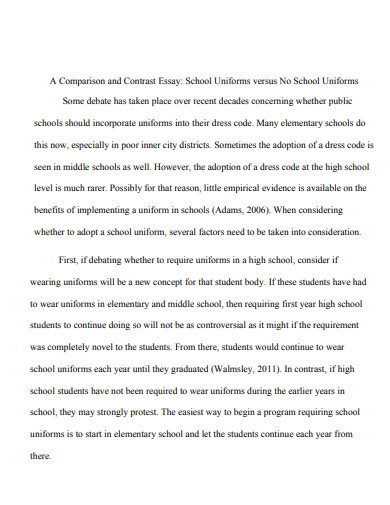
Size: 547 KB
29. Formal Comparison and Contrast Essay Example
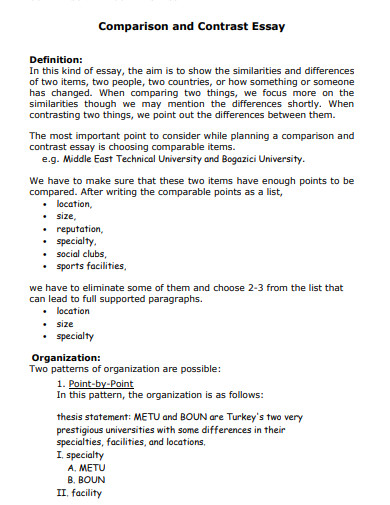
Size: 61 KB
30. Comparison and Contrast Essay Outline Example
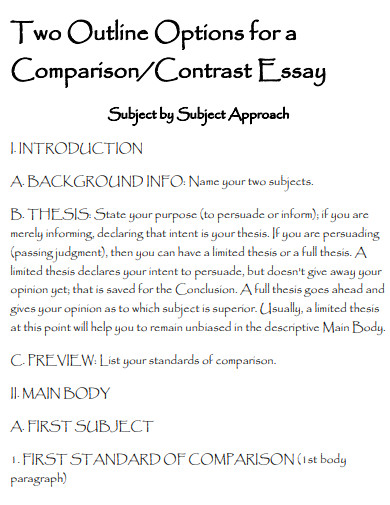
What is a Compare and Contrast Essay?
A Comparison and Contrast Essay is a type of writing that explores the similarities and differences between two or more subjects. It is a form of academic writing where the writer compares and contrasts two or more things based on specific criteria. This type of essay is common in high school and college coursework, and it can cover any subject matter, from simple topics like comparing apples and oranges to complex issues like comparing different theories of economics.
How to Write a Compare and Contrast Essay
Before we delve into the steps, it’s important to understand that writing a Comparison and Contrast Essay requires critical thinking and a clear understanding of both the subjects being compared.
Step 1: Choose Your Subjects
The first step in writing a Comparison and Contrast Essay is to choose two subjects that have similarities and differences. These could be two characters in a novel, two different novels, two historical periods, or even two scientific theories.
Step 2: Develop a Thesis
The next step is to develop a thesis. A thesis is a statement that expresses the main idea of your essay. It should clearly state what you are comparing and contrasting and why it is important.
Step 3: Organize Your Essay
Organizing your essay is crucial for clarity. There are two ways to structure a Comparison and Contrast Essay: the block method and the point-by-point method. The block method presents all arguments related to your first subject, followed by your second subject. The point-by-point method, on the other hand, alternates arguments about the two items you are comparing and contrasting.
Step 4: Write the Essay
Start with an engaging essay hook to grab your reader’s attention. Then, present your thesis and proceed to write the body of your essay, using metaphors and other literary devices to make your points more compelling. Finally, conclude your essay by summarizing your main points and restating your thesis.
What is the purpose of a Comparison and Contrast Essay?
The purpose of a Comparison and Contrast Essay is to analyze the differences and/or similarities of two distinct subjects. It helps readers understand the subjects better when they are compared to each other.
How is a Comparison and Contrast Essay different from an Argument Essay?
While both types of essays require critical thinking and a clear thesis, an Argument Essay presents an argument and supports it with evidence, while a Comparison and Contrast Essay explores the similarities and differences between two or more subjects.
Can I use a Comparison and Contrast Essay in a Collage Essay?
Yes, you can. A Collage Essay is a creative way to present information, and incorporating a Comparison and Contrast Essay can add depth and complexity to your collage.
Writing a Comparison and Contrast Essay can be a challenging task, but with the right approach and understanding, it can be an enjoyable and rewarding experience. By following the steps outlined in this guide, you can create a compelling and insightful essay. Remember, practice makes perfect, so don’t hesitate to explore the 29+ Comparison and Contrast Essay Examples in Google Docs, Word, PDF, and other 10+ Comparative Analysis Essay Examples to hone your skills.
Text prompt
- Instructive
- Professional
Write a comparison contrast essay on living in the city versus the countryside.
Compare and contrast in an essay the differences between summer and winter vacations.
What are the swing states? Electoral maps from 2016, 2020 show where votes flipped

What was likely to be a rematch of the 2020 presidential election was upended Sunday when President Joe Biden dropped out of the 2024 race .
Biden quickly endorsed Vice President Kamala Harris as his successor, and her campaign got to work immediately, gathering support from the majority of the party to shift delegate pledges from Biden to Harris.
Assuming Harris does indeed secure the nomination , she has just more than 100 days to campaign for office.
But Republican nominee Donald Trump has maintained an edge over his Democratic rival in seven states that are crucial to secure the 270 electoral votes necessary to win.
Here are the states that could likely decide the election :
Harris vs. Trump: How do the candidates compare in recent swing state polls?
What are the swing states?
The following states flipped parties in the presidential election between 2016 and 2020:
- Pennsylvania
Nebraska distributes electoral votes proportionally, and it flipped one vote blue in 2020. Nevada and North Carolina are also considered battle ground states .
Map: Joe Biden beat Donald Trump in 2020
Biden won with 306 electoral votes.
Map: Donald Trump beat Hillary Clinton in 2016
Trump won with 306 electoral votes.
Contributing: Joey Garrison, Maya Marchel Hoff

IMAGES
VIDEO
COMMENTS
Make sure they have enough similarities and differences to make a meaningful comparison. 2. Brainstorm key points: Once you have chosen the subjects, brainstorm the key points you want to compare and contrast. These could include characteristics, features, themes, or arguments related to each subject. 3.
As we discussed in "Advice on Timing" at the page on single-source analysis, that timeline itself roughly follows the "Sample Sequence of Formative Assignments for a 'Typical' Essay" outlined under "Formative Writing Assignments," and it spans about 5-6 steps or 2-4 weeks.Comparative analysis assignments have a lot of the same DNA as single-source essays, but they potentially bring more ...
Making effective comparisons. As the name suggests, comparing and contrasting is about identifying both similarities and differences. You might focus on contrasting quite different subjects or comparing subjects with a lot in common—but there must be some grounds for comparison in the first place. For example, you might contrast French ...
A comparative essay asks that you compare at least two (possibly more) items. These items will differ depending on the assignment. You might be asked to compare. positions on an issue (e.g., responses to midwifery in Canada and the United States) theories (e.g., capitalism and communism) figures (e.g., GDP in the United States and Britain)
Critical Analysis Examples. 1. Exploring Strengths and Weaknesses. Perhaps the first and most straightforward method of critical analysis is to create a simple strengths-vs-weaknesses comparison. Most things have both strengths and weaknesses - you could even do this for yourself!
Compare and Contrast Essay Basics. The Compare and Contrast Essay is a literary analysis essay, but, instead of examining one work, it examines two or more works. These works must be united by a common theme or thesis statement. For example, while a literary analysis essay might explore the significance of ghosts in William Shakespeare's Hamlet ...
By assigning such essays, your instructors are encouraging you to make connections between texts or ideas, engage in critical thinking, and go beyond mere description or summary to generate interesting analysis: when you reflect on similarities and differences, you gain a deeper understanding of the items you are comparing, their relationship ...
• Comparison narrative illustrates how two or more people are similar. • Contrast illustrates how two or more people are different. • In most academic writing, the two are combined to analyze. • In essence, you will be creating an extended analogy. • An analogy explains one thing by comparing/contrasting it to a more familiar thing.
The Structure of a Compare/Contrast Essay. The compare-and-contrast essay starts with a thesis that clearly states the two subjects that are to be compared, contrasted, or both and the reason for doing so. The thesis could lean more toward comparing, contrasting, or both. Remember, the point of comparing and contrasting is to provide useful ...
comparative essay asks that you compare at least two (possibly more) items. These items will differ depending on the assignment. You might be asked to compare. events (e.g., the Great Depression and the global financial crisis of 2008-9) Although the assignment may say "compare," the assumption is that you will consider both the ...
Use Clear Transitions. Transitions are important in compare and contrast essays, where you will be moving frequently between different topics or perspectives. Examples of transitions and phrases for comparisons: as well, similar to, consistent with, likewise, too. Examples of transitions and phrases for contrasts: on the other hand, however ...
Work in groups of 3-4, practice writing claims for comparative analysis based on possible conversations your selected authors could have. Your team will write the claims on a Google doc shared by your instructor. The whole class will then review and evaluate each claim for effectiveness and significance. To practice writing and evaluating ...
The compare-and-contrast essay starts with a thesis that clearly states the two subjects that are to be compared, contrasted, or both and the reason for doing so. The thesis could lean more toward comparing, contrasting, or both. Remember, the point of comparing and contrasting is to provide useful knowledge to the reader.
Written by MasterClass. Last updated: Jun 7, 2021 • 3 min read. Critical analysis essays can be a daunting form of academic writing, but crafting a good critical analysis paper can be straightforward if you have the right approach. Explore.
A critical analysis essay is an academic paper that requires a thorough examination of theoretical concepts and ideas. It includes a comparison of facts, differentiation between evidence and argument, and identification of biases.
A thesis statement is the author's educated opinion that can be defended. For a comparative essay, your thesis statement should assert why the similarities and differences between the literary works matter. Step 4: Create a Structure. Before drafting, create an outline. Your introduction should draw the reader in and provide the thesis statement.
Critical analysis is a process of examining a piece of work or an idea in a systematic, objective, and analytical way. It involves breaking down complex ideas, concepts, or arguments into smaller, more manageable parts to understand them better. ... The study uses a quasi-experimental design to compare the performance of students who took an ...
Compare and Contrast Essay Basics. The Compare and Contrast Essay is a literary analysis essay, but, instead of examining one work, it examines two or more works. These works must be united by a common theme or thesis statement. For example, while a literary analysis essay might explore the significance of ghosts in William Shakespeare's Hamlet ...
Yes. This three basic parts of an essay are referred to as the introduction, body of paragraphs and the conclusion. A comparative analysis essay has a primary purpose of allowing you to compare two different subjects. It may be people, events, objects, theories, etc. Its main focus is to identify the similarities and differences.
A comparative analysis is a critical investigation of two or more entities/ subjects/ processes/events, etc. in order to pinpoint similarities and differences between these and by doing so, to gain a deeper understanding of the subject. ... For my comparison essay, I chose to compare a piece by Pakistani Artist Huma Bhabha titled "It's Me ...
Literary Analysis Compare and Contrast Essay Examples. The perfect way to inform readers about the pros and cons of two subjects is with a comparison and contrast essay. It starts by stating the thesis statement, and then you explain why these two subjects are being compared in this essay. The following is an example that you can use for your help.
Allow the rough draft to sit for a day or two. Approach it with a fresh mind. Carefully proofread it and make improvements to the form and content. Write the final version of the critique based on the revisions of the original draft. Conclude the critique with a summary that touches on all the essential points of the critique.
Explore the art of writing a Comparison and Contrast Essay with our step-by-step guide. Learn from 29+ examples available in Google Docs, Word, PDF, and enhance your writing skills. ... While both types of essays require critical thinking and a clear ... PDF, and other 10+ Comparative Analysis Essay Examples to hone your skills. Share ...
ENGL1101 - Introduction to University Writing, Article Summary, Assignment 1. ENGL1101 Maljaars Alexa Assignment 1 A. ENGL1101 Maljaars Alexa Assignment 1 B. DIGNOSTIC ESSAY. Assignment 1, Sohanur Rahman, T00566857,ENGL 1101. critical comparison of debate: critical review of the bennett, maton, kervin, and digital natives myth or reality ...
Story Of An Hour Literary Analysis. 475 Words 2 Pages. ... that has a huge difference by compare with other woman in that period of time In the story, the author claims that Louise is an intelligent person by stating "she wept at once, with sudden"(line9,Chopin)after hearing the news of their husband's death rather than feeling numb like ...
Literary Analysis Essay On Beowulf; Literary Analysis Essay On Beowulf. 681 Words 3 Pages. Beowulf : An Epic Story In Denmark they had a problem with a monster named Grendel that had come around. All the men had lured him in form all the noise they had been making. He had waited until they all fell asleep and made his move on the men.
The scene of the hooded figure running across Paris rooftops is probably a familiar one for watchers of the Netflix series "Lupin," starring French actor Omar Sy and based on the literary figure.
What was likely to be a rematch of the 2020 presidential election was upended Sunday when President Joe Biden dropped out of the 2024 race.. Biden quickly endorsed Vice President Kamala Harris as ...